
The list of cloud types groups all genera as ''high'' (cirro-, cirrus), ''middle'' (alto-), ''multi-level'' (nimbo-, cumulo-, cumulus), and ''low'' (strato-, stratus). These groupings are determined by the altitude level or levels in the troposphere at which each of the various cloud types is normally found. Small cumulus are commonly grouped with the low clouds because they do not show significant vertical extent. Of the multi-level genus-types, those with the greatest convective activity are often grouped separately as ''towering vertical''. The genus types all have Latin names.
The genera are also grouped into five physical forms. These are, in approximate ascending order of instability or convective activity: ''stratiform'' sheets; ''cirriform'' wisps and patches; ''stratocumuliform'' patches, rolls, and ripples; ''cumuliform'' heaps, and ''cumulonimbiform'' towers that often have complex structures. Most genera are divided into ''species'' with Latin names, some of which are common to more than one genus. Most genera and species can be subdivided into ''varieties'', also with Latin names, some of which are common to more than one genus or species. The essentials of the modern nomenclature system for tropospheric clouds were proposed by
Luke Howard
Luke Howard, (28 November 1772 – 21 March 1864) was a British manufacturing chemist and an amateur meteorologist with broad interests in science. His lasting contribution to science is a nomenclature system for clouds, which he proposed ...
, a
British
British may refer to:
Peoples, culture, and language
* British people, nationals or natives of the United Kingdom, British Overseas Territories, and Crown Dependencies.
** Britishness, the British identity and common culture
* British English, ...
manufacturing
chemist
A chemist (from Greek ''chēm(ía)'' alchemy; replacing ''chymist'' from Medieval Latin ''alchemist'') is a scientist trained in the study of chemistry. Chemists study the composition of matter and its properties. Chemists carefully describe th ...
and an
amateur
An amateur () is generally considered a person who pursues an avocation independent from their source of income. Amateurs and their pursuits are also described as popular, informal, self-taught, user-generated, DIY, and hobbyist.
History
...
meteorologist
A meteorologist is a scientist who studies and works in the field of meteorology aiming to understand or predict Earth's atmospheric phenomena including the weather. Those who study meteorological phenomena are meteorologists in research, while t ...
with broad interests in
science
Science is a systematic endeavor that builds and organizes knowledge in the form of testable explanations and predictions about the universe.
Science may be as old as the human species, and some of the earliest archeological evidence ...
, in an 1802 presentation to the
Askesian Society. Very low stratiform clouds that touch the Earth's surface are given the common names ''fog'' and ''mist'', which are not included with the Latin nomenclature of clouds that form aloft in the troposphere.
Above the troposphere,
stratospheric
The stratosphere () is the second layer of the atmosphere of the Earth, located above the troposphere and below the mesosphere. The stratosphere is an atmospheric layer composed of stratified temperature layers, with the warm layers of air h ...
and
mesospheric clouds have their own classifications with common names for the major types and alpha-numeric nomenclature for the subtypes. They are characterized by altitude as ''very high level'' (polar stratospheric) and ''extreme level'' (polar mesospheric). Three of the five physical forms in the troposphere are also seen at these higher levels, stratiform, cirriform, and stratocumuliform, although the tops of very large cumulonimbiform clouds can penetrate the lower stratosphere.
Cloud identification and classification: Order of listed types
In section two of this page (Classification of major types), height ranges are sorted in approximate descending order of altitude expressed in general terms. On the cross-classification table, forms and genus types (including some genus sub-types) are shown from left to right in approximate ascending order of instability.
In sections three to five, terrestrial clouds are listed in descending order of the altitude range of each atmospheric layer in which clouds can form:
* mesospheric layer;
* stratospheric layer;
* tropospheric layer.
** Within the troposphere, the cloud levels are listed in descending order of altitude range.
*** Non-vertical genus types (including some genus sub-types) are sorted into approximate descending order of altitude of the cloud bases.
*** Vertical or multi-level genera and genus sub-types can be based in the low or middle levels and are therefore placed between the non-vertical low and mid-level genus types and sub-types. These thick clouds are listed in approximate descending order of altitude of the cloud tops.
**** The species associated with each genus type are listed in approximate ascending order of instability where applicable.
**** The constituent varieties and associated supplementary features and mother clouds for each genus or species are arranged in approximate order of frequency of occurrence.
****A count of basic tropospheric variants that result from the division and subdivision of genus types into species and varieties is shown as a number in parentheses from V-1 (variant 1) through V-92 after each variety, after nimbostratus that has no sub-types, and after certain species that are not always dividable into varieties.
In section six, the cloud types in the general lists and the mother clouds in the applicable classification table are sorted in alphabetical order except where noted. The species table shows these types sorted from left to right in approximate ascending order of the convective instability of each species. The table for supplementary features has them arranged in approximate descending order of frequency of occurrence.
In section seven, extraterrestrial clouds can be found in the atmospheres of other planets in our solar system and beyond. The planets with clouds are listed (not numbered) in order of their distance from the sun, and the clouds on each planet are in approximate descending order of altitude.
Cloud cross-classification throughout the homosphere
The table that follows is very broad in scope much like the cloud template that follows it at the bottom of the page. There are some variations in styles of nomenclature between the classification scheme used for the troposphere (strict Latin except for surface based aerosols) and the higher levels of the homosphere (common terms, some informally derived from Latin). However, the schemes presented here share a cross-classification of physical forms and altitude levels to derive the 10 tropospheric genera,
the fog and mist that forms at surface level, and several additional major types above the troposphere. The cumulus genus includes four species that indicate vertical size which can affect the altitude levels.
The main tropospheric two-letter abbreviations in alphabetical order
Polar mesospheric cloud identification and classification
Clouds that form in the mesosphere come in a variety of forms such as veils, bands, and billows, but are not given Latin names based on those characteristic. Polar mesospheric clouds are the highest in the atmosphere and are given the Latin-derived name
noctilucent which refers to their illumination during deep
twilight
Twilight is light produced by sunlight scattering in the upper atmosphere, when the Sun is below the horizon, which illuminates the lower atmosphere and the Earth's surface. The word twilight can also refer to the periods of time when this i ...
rather than their physical forms. They are sub-classified alpha-numerically and with common terms according to specific details of their physical structures.
Extreme-level stratiform, stratocumuliform, and cirriform
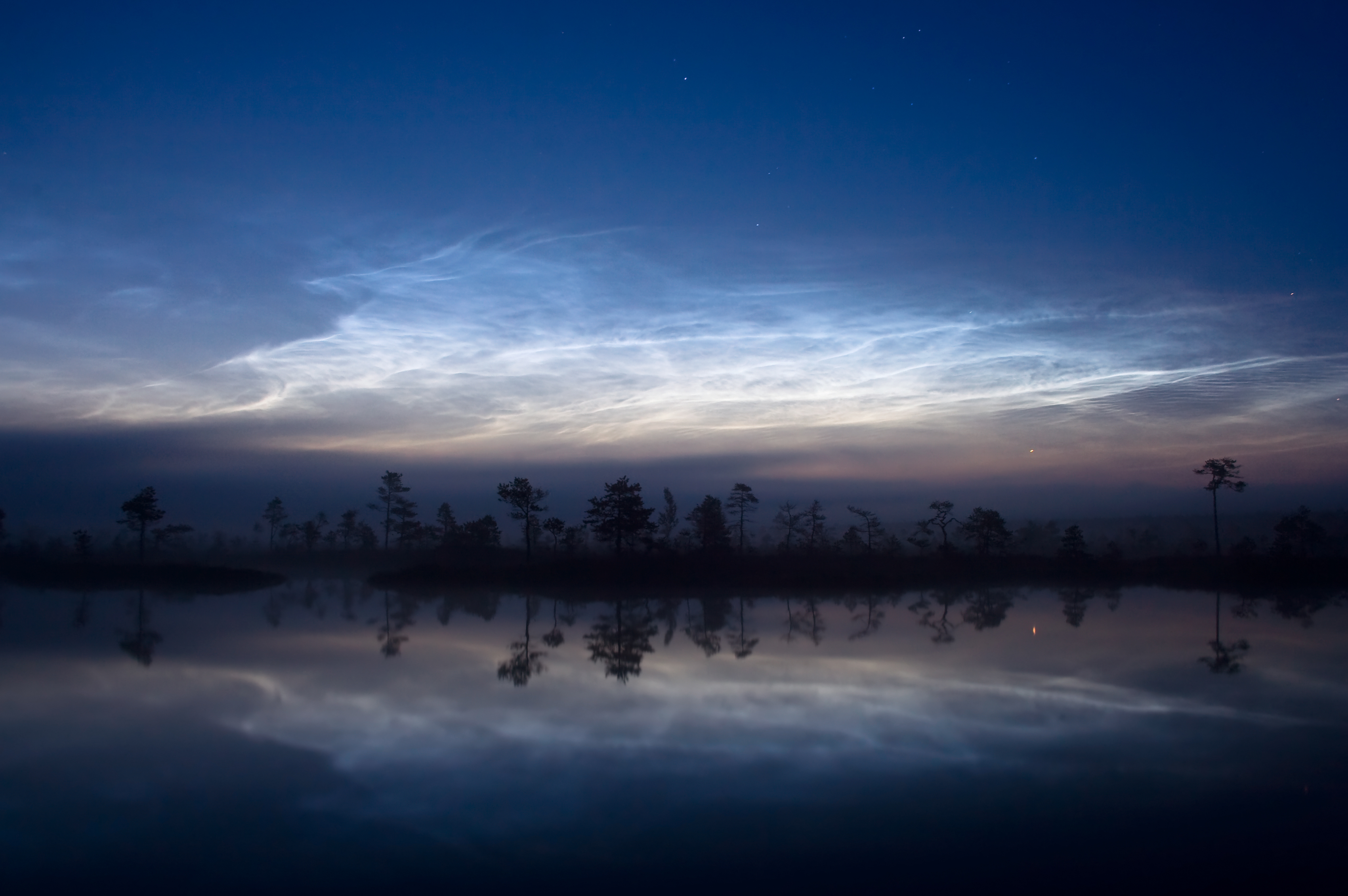 Noctilucent cloud
Noctilucent clouds are thin clouds that come in a variety of forms based from about and occasionally seen in deep twilight after sunset and before sunrise.
;Type 1 : Veils, very tenuous stratiform; resembles cirrostratus or poorly defined cirrus.
;Type 2 : Long stratocumuliform bands, often in parallel groups or interwoven at small angles. More widely spaced than cirrocumulus bands.
:;2A : Bands with diffuse, blurred edges.
:;2B : Bands with sharply defined edges.
;Type 3: Billows. Clearly spaced, fibrous cirriform, roughly parallel short streaks.
:;3A : Short, straight, narrow streaks.
:;3B : Wave-like structures with undulations.
;Type 4 : Whirls. Partial (or, more rarely, complete) cirriform rings with dark centers.
:;4A : Whirls possessing a small angular radius of curvature, sometimes resembling light ripples on a water surface.
:;4B : Simple curve of medium angular radius with one or more streaks.
:;4C : Whirls with large-scale ring structures.
Polar stratospheric cloud identification and classification
 Polar stratospheric clouds
Polar stratospheric clouds form at very high altitudes in
polar
Polar may refer to:
Geography
Polar may refer to:
* Geographical pole, either of two fixed points on the surface of a rotating body or planet, at 90 degrees from the equator, based on the axis around which a body rotates
*Polar climate, the cli ...
regions of the stratosphere. Those that show
mother-of-pearl
Nacre ( , ), also known as mother of pearl, is an organicinorganic composite material produced by some molluscs as an inner shell layer; it is also the material of which pearls are composed. It is strong, resilient, and iridescent.
Nacre is ...
color
Color (American English) or colour (British English) is the visual perceptual property deriving from the spectrum of light interacting with the photoreceptor cells of the eyes. Color categories and physical specifications of color are associ ...
s are given the name ''nacreous''.
Very high-level stratiform
;Nitric acid and water polar stratospheric : Sometimes known as type 1, a thin sheet-like cloud resembling cirrostratus or haze. Contains supercooled
nitric acid
Nitric acid is the inorganic compound with the formula . It is a highly corrosive mineral acid. The compound is colorless, but older samples tend to be yellow cast due to decomposition into oxides of nitrogen. Most commercially available ni ...
and water droplets; sometimes also contains supercooled
sulfuric acid
Sulfuric acid (American spelling and the preferred IUPAC name) or sulphuric acid ( Commonwealth spelling), known in antiquity as oil of vitriol, is a mineral acid composed of the elements sulfur, oxygen and hydrogen, with the molecular fo ...
in ternary solution.
Very high-level cirriform and stratocumuliform
;
Nacreous polar stratospheric cloud (mother of pearl): Sometimes known as type 2, a thin usually cirriform or lenticular (stratocumuliform) looking cloud based from about and seen most often between
sunset
Sunset, also known as sundown, is the daily disappearance of the Sun below the horizon due to Earth's rotation. As viewed from everywhere on Earth (except the North and South poles), the equinox Sun sets due west at the moment of both the spr ...
and
sunrise
Sunrise (or sunup) is the moment when the upper rim of the Sun appears on the horizon in the morning. The term can also refer to the entire process of the solar disk crossing the horizon and its accompanying atmospheric effects.
Terminology
A ...
.
Consists of ice crystals only.
Cloud identification and classification in the troposphere
Tropospheric clouds are divided into physical forms defined by structure, and levels defined by altitude range. These divisions are cross-classified to produce ten basic genus-types. They have Latin names as authorized by the
World Meteorological Organization
The World Meteorological Organization (WMO) is a specialized agency of the United Nations responsible for promoting international cooperation on atmospheric science, climatology, hydrology and geophysics.
The WMO originated from the Inter ...
(WMO) that indicate physical structure, altitude or étage, and process of formation.
High-level cirriform, stratocumuliform, and stratiform
High clouds form in the highest and coldest region of the troposphere from about 5 to 12 km (16,500 to 40,000 ft) in temperate latitudes.
At this altitude water almost always freezes so high clouds are generally composed of
ice crystal
Ice crystals are solid ice exhibiting atomic ordering on various length scales and include hexagonal columns, hexagonal plates, dendritic crystals, and diamond dust.
Formation
The hugely symmetric shapes are due to depositional growth, n ...
s or supercooled water droplets.
Genus cirrus
Abbreviation: Ci
Cirriform clouds tend to be wispy and are mostly transparent or translucent. Isolated cirrus do not bring
rain
Rain is water droplets that have condensed from atmospheric water vapor and then fall under gravity. Rain is a major component of the water cycle and is responsible for depositing most of the fresh water on the Earth. It provides water f ...
; however, large amounts of cirrus can indicate an approaching
storm
A storm is any disturbed state of the natural environment or the atmosphere of an astronomical body. It may be marked by significant disruptions to normal conditions such as strong wind, tornadoes, hail, thunder and lightning (a thunderstorm), ...
system eventually followed by fair
weather
Weather is the state of the atmosphere, describing for example the degree to which it is hot or cold, wet or dry, calm or stormy, clear or cloudy. On Earth, most weather phenomena occur in the lowest layer of the planet's atmosphere, the ...
.
There are several variations of clouds of the cirrus genus based on species and varieties:
=Species
=
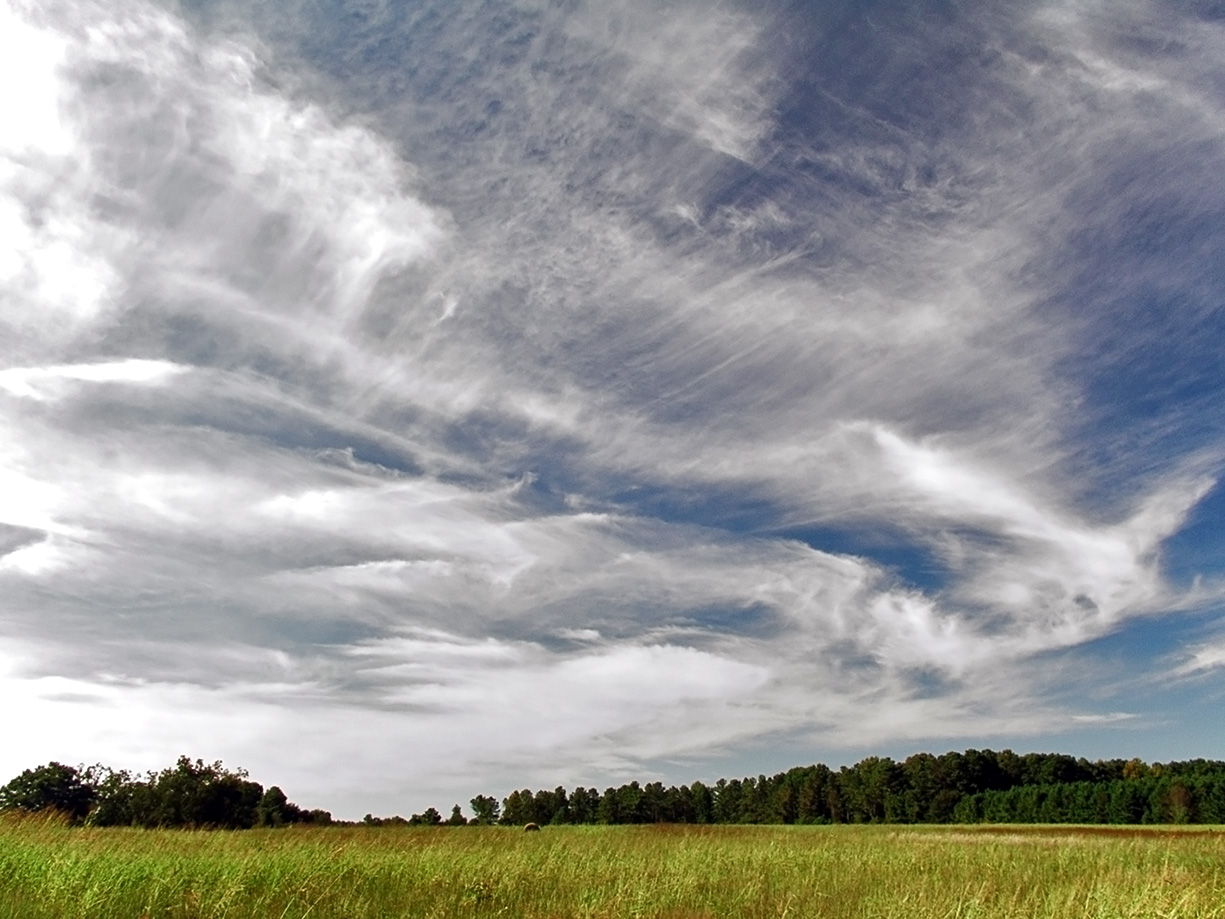

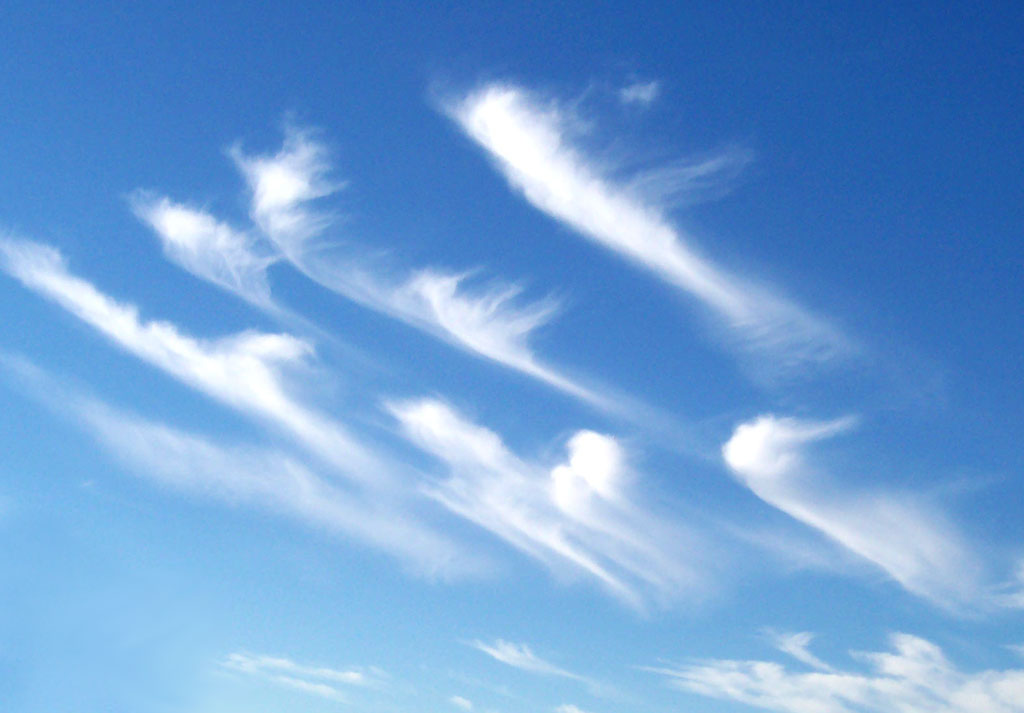
;
Cirrus fibratus (V-1): High clouds having the traditional "mare's tail" appearance. These clouds are long, fibrous, and curved, with no tufts or curls at the ends.
;
Cirrus uncinus (V-2): Filaments with up-turned hooks or curls.
;
Cirrus spissatus (V-3): Dense and opaque or mostly opaque patches.
;
Cirrus castellanus
Cirrus castellanus or Cirrus castellatus is a species of cirrus cloud. Its name comes from the word ''castellanus'', which means ''of a fort'', ''of a castle'' in Latin. Like all cirrus, this species occurs at high altitudes. It appears as separat ...
(V-4): A series of dense lumps, or "towers", connected by a thinner base.
;
Cirrus floccus (V-5): Elements which take on a rounded appearance on the top, with the lower part appearing ragged.
=Varieties
=
; Opacity-based: None; always translucent except species spissatus which is inherently opaque.
; Fibratus pattern-based:
:;
Cirrus fibratus intortus (V-6): Irregularly curved or tangled filaments.
:;
Cirrus fibratus vertebratus (V-7): Elements arranged in the manner of a
vertebrate
Vertebrates () comprise all animal taxa within the subphylum Vertebrata () ( chordates with backbones), including all mammals, birds, reptiles, amphibians, and fish. Vertebrates represent the overwhelming majority of the phylum Chordata, with ...
or
fish
Fish are Aquatic animal, aquatic, craniate, gill-bearing animals that lack Limb (anatomy), limbs with Digit (anatomy), digits. Included in this definition are the living hagfish, lampreys, and Chondrichthyes, cartilaginous and bony fish as we ...
skeleton
A skeleton is the structural frame that supports the body of an animal. There are several types of skeletons, including the exoskeleton, which is the stable outer shell of an organism, the endoskeleton, which forms the support structure inside ...
.
; Pattern-based variety radiatus: Large horizontal bands that appear to converge at the
horizon
The horizon is the apparent line that separates the surface of a celestial body from its sky when viewed from the perspective of an observer on or near the surface of the relevant body. This line divides all viewing directions based on whether i ...
; normally associated with fibratus and uncinus species.
:;
Cirrus fibratus radiatus (V-8):
:; Cirrus uncinus radiatus (V-9):
; Pattern-based variety duplicatus: Sheets at different layers of the upper troposphere, which may be connected at one or more points; normally associated with fibratus and uncinus species.
:;
Cirrus fibratus duplicatus (V-10):
:; Cirrus uncinus duplicatus (V-11):
; Spissatus,
castellanus, or floccus
: Varieties are not commonly associated.
=Supplementary features
=
; Precipitation-based: Not associated with cirrus.
; Cloud-based:
:; Mamma: Bubble-like downward protuberances; mostly seen with species castellanus.
; Genitus mother clouds:
:; Cirrus cirrocumulogenitus:
:; Cirrus altocumulogenitus:
:; Cirrus cumulonimbogenitus:
:; Cirrus homogenitus: Cirrus formed by spreading of aircraft contrails.
; Mutatus mother cloud:
:; Cirrus cirrostratomutatus:
:; Cirrus homomutatus: Cirrus formed by the complete transformation of cirrus homogenitus.
Genus cirrocumulus
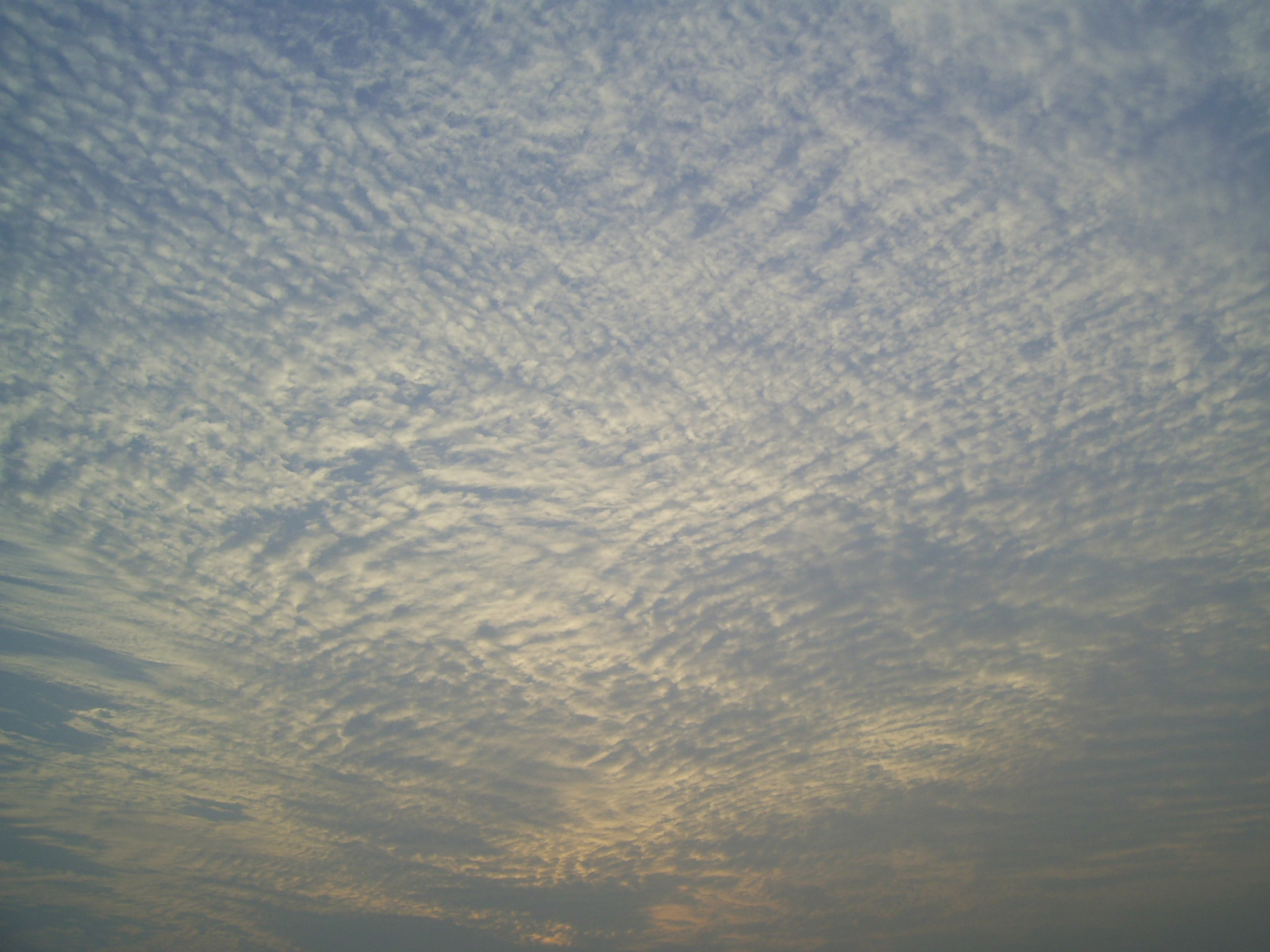
Abbreviation: Cc.
High-level stratocumuliform clouds of the genus
cirrocumulus form when moist air at high tropospheric altitude reaches saturation, creating ice crystals or supercooled water droplets. Limited convective instability at the cloud level gives the cloud a rolled or rippled appearance. Despite the lack of a ''strato-'' prefix, layered cirrocumulus is physically a high stratocumuliform genus.
[Burroughs, William James; Crowder, Bob (January 2007). ''Weather'', p.216. Fog City Press, San Francisco. .]
=High stratocumuliform species
=
;
Cirrocumulus stratiformis (V-12): Sheets or relatively flat patches of cirrocumulus.
;
Cirrocumulus lenticularis (V-13): Lenticular, or
lens
A lens is a transmissive optical device which focuses or disperses a light beam by means of refraction. A simple lens consists of a single piece of transparent material, while a compound lens consists of several simple lenses (''elements ...
-shaped high cloud.
;
Cirrocumulus castellanus (V-14): Cirrocumulus layer with "towers", or
turret
Turret may refer to:
* Turret (architecture), a small tower that projects above the wall of a building
* Gun turret, a mechanism of a projectile-firing weapon
* Objective turret, an indexable holder of multiple lenses in an optical microscope
* M ...
s joined at the bases.
;
Cirrocumulus floccus (V-15): Very small white heaps with ragged bases and rounded tops.
=Varieties
=
; Opacity-based varieties: None (always translucent).
; Pattern-based varieties:
:; Undulatus: Cirrocumulus with an undulating base; normally associated with stratiformis and lenticularis species.
::; Stratocumuliform undulatus (V-16):
::;
Cirrocumulus stratiformis undulatus (V-17):
::; Cirrocumulus lenticularis undulatus
(V-18):
:; Lacunosus: Cirrocumulus with large clear holes; normally associated with stratiformis and
castellanus species (also with cumuliform floccus species).
::; Stratocumuliform lacunosus:
::;
Cirrocumulus stratiformis lacunosus (V-19):
::; Cirrocumulus castellanus lacunosus (V-20):
::; Cirrocumulus floccus lacunosus
(V-21):
=Supplementary features
=
; Precipitation-based supplementary feature:
:; Virga: Light
precipitation
In meteorology, precipitation is any product of the condensation of atmospheric water vapor that falls under gravitational pull from clouds. The main forms of precipitation include drizzle, rain, sleet, snow, ice pellets, graupel and hail. ...
that evaporates well above ground level; mostly seen with species stratiformis, castellanus, and floccus.
; Cloud-based supplementary feature:
:; Mamma: Bubble-like downward protuberances; mostly seen with species castellanus.
; Genitus mother clouds: No genitus types.
; Mutatus mother clouds:
:; Cirrocumulus cirromutatus
:; Cirrocumulus cirrostratomutatus
:; Cirrocumulus altocumulomutatus
:; Cirrocumulus homomutatus: Results from the transformation of cirrus homogenitus.
Genus cirrostratus

Abbreviation: Cs

Clouds of the genus
cirrostratus
Cirrostratus is a high-level, very thin, generally uniform ''stratiform'' genus-type of cloud. It is made out of ice-crystals, which are pieces of frozen water. It is difficult to detect and it can make halos. These are made when the cloud takes ...
consist of mostly continuous, wide sheets of cloud that covers a large area of the sky. It is formed when convectively stable moist air cools to saturation at high altitude, forming ice crystals.
[Burroughs, William James; Crowder, Bob (January 2007). ''Weather'', p.215. Fog City Press, San Francisco. .] Frontal cirrostratus is a precursor to rain or
snow
Snow comprises individual ice crystals that grow while suspended in the atmosphere—usually within clouds—and then fall, accumulating on the ground where they undergo further changes.
It consists of frozen crystalline water throughou ...
if it thickens into mid-level altostratus and eventually nimbostratus, as the
weather front
A weather front is a boundary separating air masses for which several characteristics differ, such as air density, wind, temperature, and humidity. Disturbed and unstable weather due to these differences often arises along the boundary. For in ...
moves closer to the observer.
=Species
=
;
Cirrostratus fibratus
Cirrostratus fibratus or also called Cirrostratus filosus is a type of cirrostratus cloud. The name ''cirrostratus fibratus'' is derived from Latin, meaning "fibrous". Cirrostratus fibratus is one of the two most common forms that cirrostratus of ...
(V-22): Cirrostratus sheet with a fibrous appearance, but not as detached as cirrus.
;
Cirrostratus nebulosus
Cirrostratus nebulosus is a type of high-level cirrostratus cloud. The name ''cirrostratus nebulosus'' is derived from Latin, the adjective ''nebulosus'' meaning "full of vapor, foggy, cloudy, dark". Cirrostratus nebulosus is one of the two most c ...
(V-23): Featureless, uniform sheet.
=Varieties
=
; Opacity-based varieties: None (always translucent)
; Fibratus pattern-based varieties:
:; Cirrostratus fibratus duplicatus
(V-24): Separate or semi-merged sheets with one layer slightly above the other.
:; Cirrostratus fibratus undulatus
(V-25): Undulating
wave
In physics, mathematics, and related fields, a wave is a propagating dynamic disturbance (change from equilibrium) of one or more quantities. Waves can be periodic, in which case those quantities oscillate repeatedly about an equilibrium (re ...
s.
; Varieties are not commonly associated with Cs species nebulosus.
=Supplementary features
=
: Supplementary features/accessory clouds: Not associated with cirrostratus.
; Genitus mother clouds:
:; Cirrostratus cirrocumulogenitus:
:; Cirrostratus cumulonimbogenitus:
; Mutatus mother clouds:
:; Cirrostratus cirromutatus:
:; Cirrostratus cirrocumulomutatus:
:; Cirrostratus altostratomutatus:
:; Cirrostratus homomutatus: Results from the transformation of cirrus homogenitus.
Mid-level stratocumuliform and stratiform
Middle cloud forms from 2 to 7 km (6,500–23,000 ft) in temperate latitudes, and may be composed of water droplets or ice crystals depending on the temperature profile at that altitude range.
Genus altocumulus


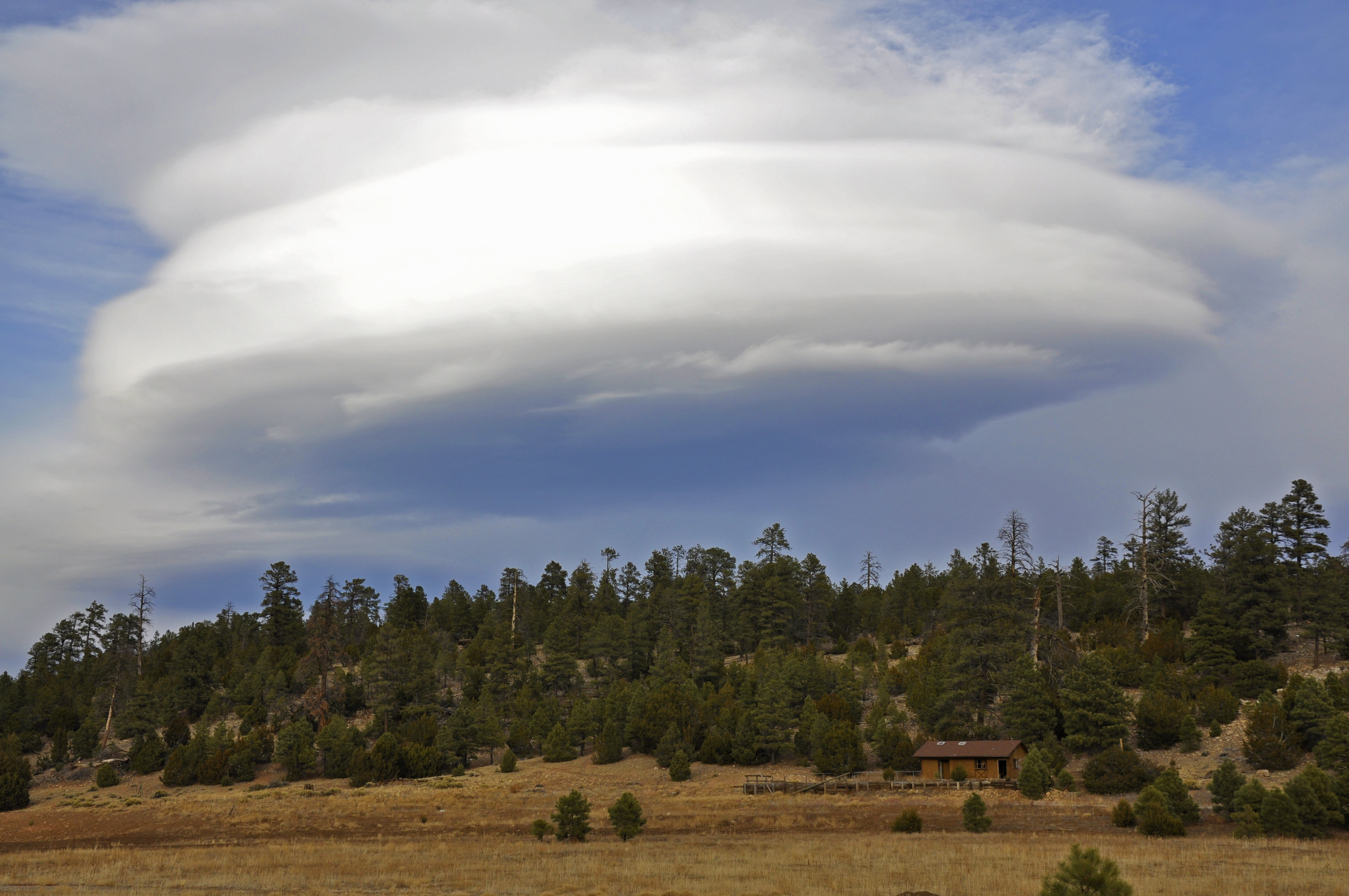



Abbreviation: Ac
Mid-level stratocumuliform clouds of the genus
altocumulus
Altocumulus (From Latin ''Altus'', "high", ''cumulus'', "heaped") is a middle-altitude cloud genus that belongs mainly to the ''stratocumuliform'' physical category characterized by globular masses or rolls in layers or patches, the individual ele ...
are not always associated with a weather front but can still bring precipitation, usually in the form of
virga
In meteorology, a virga, also called a dry storm, is an observable streak or shaft of precipitation falling from a cloud that evaporates or sublimates before reaching the ground. A shaft of precipitation that does not evaporate before rea ...
which does not reach the ground. Layered forms of altocumulus are generally an indicator of limited convective instability, and are therefore mainly stratocumuliform in structure.
=Mid-level stratocumuliform species
=
;
Altocumulus stratiformis: Always dividable into opacity-based varieties. Sheets or relatively flat patches of altocumulus.
;
Altocumulus lenticularis (V-26): Lens-shaped middle cloud. Includes informal variant altocumulus
Kelvin–Helmholtz cloud, lenticular spiral indicative of severe
turbulence
In fluid dynamics, turbulence or turbulent flow is fluid motion characterized by chaotic changes in pressure and flow velocity. It is in contrast to a laminar flow, which occurs when a fluid flows in parallel layers, with no disruption between ...
.
;
Altocumulus volutus (V-27): Elongated, tube shaped, horizontal stratocumuliform cloud.
;
Altocumulus castellanus (V-28): Turreted layer cloud.
;
Altocumulus floccus (V-29): Tufted stratocumuliform clouds with ragged bases.
=Varieties
=
; Opacity-based varieties:
:; Altocumulus stratiformis translucidus (V-30): Translucent altocumulus through which the
sun
The Sun is the star at the center of the Solar System. It is a nearly perfect ball of hot plasma, heated to incandescence by nuclear fusion reactions in its core. The Sun radiates this energy mainly as light, ultraviolet, and infrared radi ...
or moon can be seen.
:; Altocumulus stratiformis perlucidus (V-31): Opaque middle clouds with translucent breaks.
:; Altocumulus stratiformis opacus (V-32): Opaque altocumulus that obscures the sun or
moon
The Moon is Earth's only natural satellite. It is the fifth largest satellite in the Solar System and the largest and most massive relative to its parent planet, with a diameter about one-quarter that of Earth (comparable to the width of ...
.
; Pattern-based varieties:
:; Radiatus: Rows of altocumulus that appear to converge at the horizon; normally associated with stratiformis species.
::; Altocumulus stratiformis translucidus radiatus (V-33):
::; Altocumulus stratiformis perlucidus radiatus (V-34):
::; Altocumulus stratiformis opacus radiatus (V-35):
:; Duplicatus: Altocumulus in closely spaced layers, one above the other; normally associated with stratiformis and lenticularis species.
::; Altocumulus stratiformis translucidus duplicatus (V-36):
::; Altocumulus stratiformis perlucidus duplicatus (V-37):
::; Altocumulus stratiformis opacus duplicatus (V-38):
::; Altocumulus lenticularis duplicatus (V-39):
:; Undulatus: Altocumulus with wavy undulating base; normally associated with stratiformis and lenticularis species.
::;
Altocumulus stratiformis translucidus undulatus (V-40):
::; Altocumulus stratiformis perlucidus undulatus (V-41):
::; Altocumulus stratiformis opacus undulatus (V-42):
::; Altocumulus lenticularis undulatus (V-43):
:; Lacunosus: Altocumulus with circular holes caused by localized
downdraft
In meteorology, an updraft is a small-scale current of rising air, often within a cloud.
Overview
Localized regions of warm or cool air will exhibit vertical movement. A mass of warm air will typically be less dense than the surrounding region, ...
s; normally associated with stratiformis and castellanus species (also with cumuliform floccus species).
::; Altocumulus stratiformis translucidus lacunosus (V-44):
::; Altocumulus stratiformis perlucidus lacunosus (V-45):
::; Altocumulus stratiformis opacus lacunosus (V-46):
::; Altocumulus castellanus lacunosus (V-47):
::; Altocumulus floccus lacunosus
(V-48):
=Supplementary features
=
; Precipitation-based supplementary feature:
:; Virga: Altocumulus producing precipitation that evaporates before reaching the ground; usually associated with species stratiformis, castellanus, and floccus.
; Cloud-based supplementary feature:
:; Mamma: Altocumulus (usually species castellanus) with downward facing bubble-like protuberances caused by localized downdrafts within the cloud.
; Genitus mother clouds:
:; Altocumulus cumulogenitus:
:; Altocumulus cumulonimbogenitus:
; Mutatus mother clouds:
:; Altocumulus cirrocumulomutatus:
:; Altocumulus altostratomutatus:
:; Altocumulus nimbostratomutatus:
:; Altocumulus stratocumulomutatus:
Genus altostratus
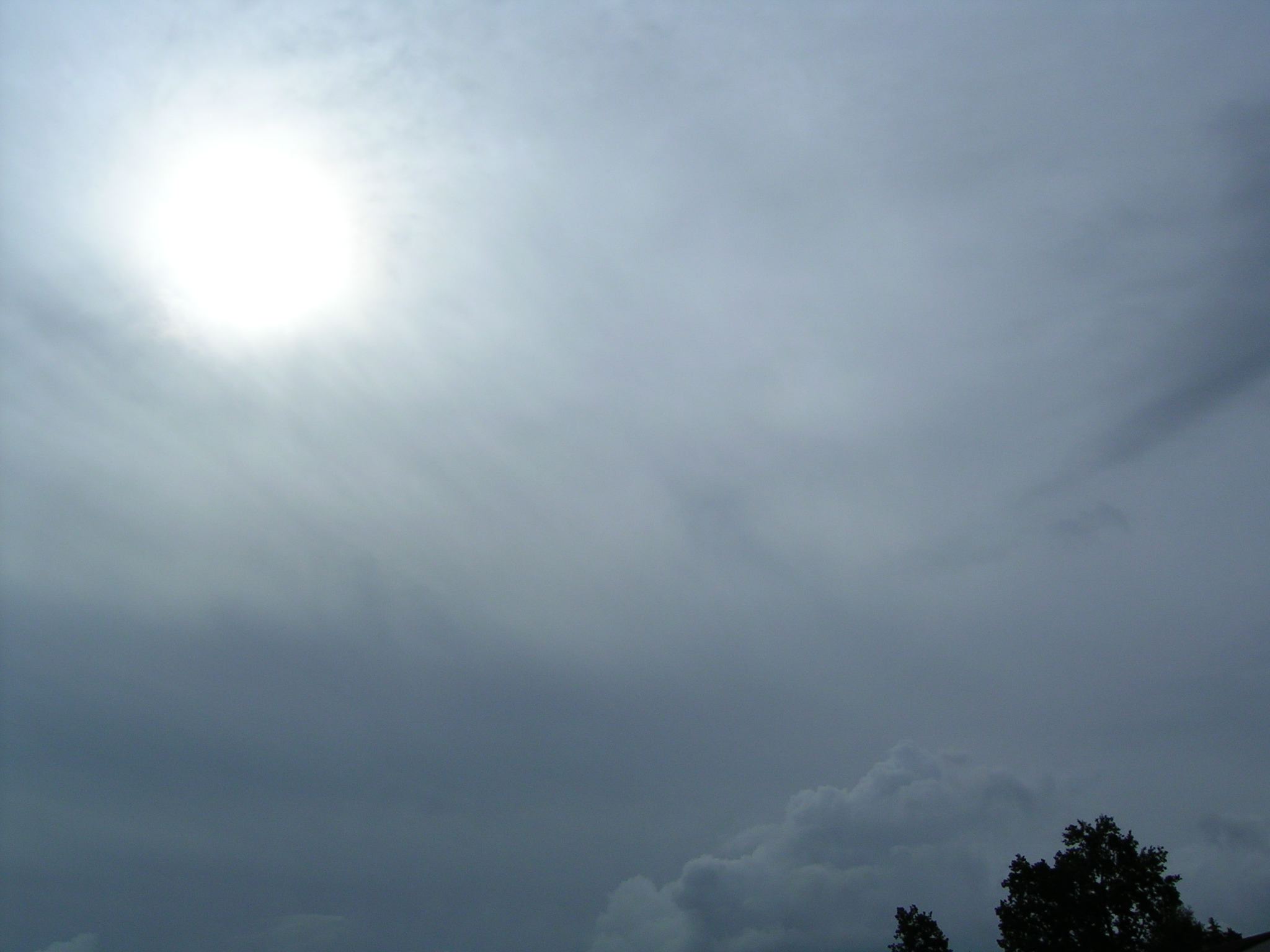
Abbreviation: As
Stratiform clouds of the genus
altostratus form when a large convectively stable airmass is lifted to condensation in the middle level of the troposphere, usually along a frontal system. Altostratus can bring light rain or snow. If the precipitation becomes continuous, it may thicken into nimbostratus which can bring precipitation of moderate to heavy intensity.
=Species
=
No differentiated species (always nebulous).
=Varieties
=
; Opacity-based varieties:
:; Altostratus translucidus (V-49): Altostratus through which the sun can be seen.
:; Altostratus opacus (V-50): Altostratus that completely blocks out the sun.
; Pattern-based variety radiatus: Bands that appear to converge at the horizon.
:; Altostratus translucidus radiatus (V-51):
:; Altostratus opacus radiatus (V-52):
; Pattern-based variety duplicatus: Altostratus in closely spaced layers, one above the other.
:; Altostratus translucidus duplicatus (V-53):
:; Altostratus opacus duplicatus (V-54):
; Pattern-based variety undulatus: Altostratus with wavy undulating base.
:;
Altostratus translucidus undulatus (V-55):
:; Altostratus opacus undulatus
(V-56):
=Supplementary features
=
; Precipitation-based supplementary features:
:; Virga: Accompanied by precipitation that evaporates before reaching the ground. Seen mostly with opacus varieties.
:; Praecipitatio: Produces precipitation that reaches the ground; associated with opacus varieties.
; Cloud-based supplementary feature:
:; Mamma: Altostratus with downward facing bubble-like protuberances caused by localized downdrafts within the cloud.
;
Accessory cloud: Seen mostly with opacus varieties
:; Pannus: Accompanied by ragged lower layer of fractus species clouds forming in precipitation.
; Genitus mother clouds:
:; Altostratus altocumulogenitus:
:; Altostratus cumulonimbogenitus:
; Mutatus mother clouds:
:; Altostratus cirrostratomutatus:
:; Altostratus nimbostratomutatus:
Towering vertical cumulonimbiform and cumuliform (low to mid-level cloud base)
Clouds with upward-growing vertical development usually form below ,
but can be based as high as in temperate climates, and often much higher in arid regions.
Genus cumulonimbus: Towering vertical

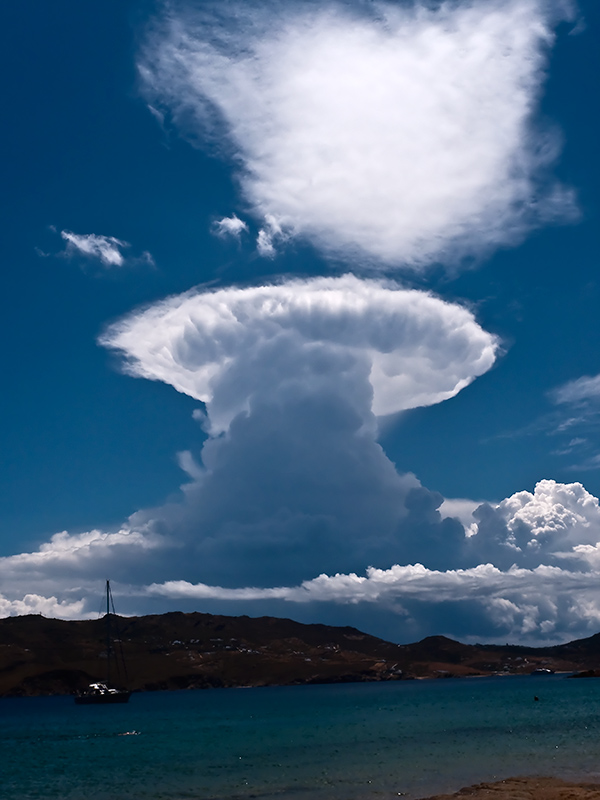
Abbreviation: Cb
Clouds of the genus cumulonimbus have very-dark-gray-to-nearly-black flat bases and very high tops that can penetrate the
tropopause
The tropopause is the atmospheric boundary that demarcates the troposphere from the stratosphere; which are two of the five layers of the atmosphere of Earth. The tropopause is a thermodynamic gradient-stratification layer, that marks the end of ...
. They develop from cumulus when the
airmass
In astronomy, air mass or airmass is a measure of the amount of air along the line of sight when observing a star or other celestial source from below Earth's atmosphere ( Green 1992). It is formulated as the integral of air density along the lig ...
is convectively highly unstable. They generally produce
thunderstorms
A thunderstorm, also known as an electrical storm or a lightning storm, is a storm characterized by the presence of lightning and its acoustic effect on the Earth's atmosphere, known as thunder. Relatively weak thunderstorms are somet ...
,
rain
Rain is water droplets that have condensed from atmospheric water vapor and then fall under gravity. Rain is a major component of the water cycle and is responsible for depositing most of the fresh water on the Earth. It provides water f ...
or
showers
A shower is a place in which a person bathes under a spray of typically warm or hot water. Indoors, there is a drain in the floor. Most showers have temperature, spray pressure and adjustable showerhead nozzle. The simplest showers have a ...
, and sometimes
hail
Hail is a form of solid precipitation. It is distinct from ice pellets (American English "sleet"), though the two are often confused. It consists of balls or irregular lumps of ice, each of which is called a hailstone. Ice pellets generally fal ...
, strong
outflow wind
Wind is the natural movement of air or other gases relative to a planet's surface. Winds occur on a range of scales, from thunderstorm flows lasting tens of minutes, to local breezes generated by heating of land surfaces and lasting a few ...
s, and/or
tornadoes
A tornado is a violently rotating column of air that is in contact with both the surface of the Earth and a cumulonimbus cloud or, in rare cases, the base of a cumulus cloud. It is often referred to as a twister, whirlwind or cyclone, alth ...
at ground level.
=Species
=
;
Cumulonimbus calvus (V-57): Cumulonimbus with high domed top.
;
Cumulonimbus capillatus (V-58): Towering vertical cloud with high cirriform top.
=Varieties
=
No varieties (always opaque and does not form in patterns visible from surface level).
=Supplementary features
=
; Precipitation-based supplementary features: Associated with calvus and capillatus species.
:; Virga: Precipitation that evaporates before reaching the ground.
:; Praecipitatio: Precipitation that reaches the ground.
; Cloud-based supplementary features:
:;
Incus (species capillatus only): Cumulonimbus with flat anvil-like cirriform top caused by wind shear where the rising air currents hit the
inversion
Inversion or inversions may refer to:
Arts
* , a French gay magazine (1924/1925)
* ''Inversion'' (artwork), a 2005 temporary sculpture in Houston, Texas
* Inversion (music), a term with various meanings in music theory and musical set theory
* ...
layer at the tropopause.
:; Mamma: Also sometimes called
Mammatus
Mammatus (also called mamma or mammatocumulus, meaning "mammary cloud") is a cellular pattern of pouches hanging underneath the base of a cloud, typically a cumulonimbus raincloud, although they may be attached to other classes of parent clou ...
, consisting of bubble-like protrusions on the underside caused by localized downdrafts.
:;
Arcus (including
roll and
shelf clouds): Low, horizontal cloud formation associated with the leading edge of thunderstorm outflow.
:; Tuba: Column hanging from the cloud base which can develop into a funnel cloud or tornado.
;
Accessory clouds: Seen with species and capillatus except where noted.
:; Pannus: Accompanied by a lower layer of fractus species cloud forming in precipitation.
:; Pileus (species calvus only): Small cap-like cloud over parent cumulonimbus.
:; Velum: A thin horizontal sheet that forms around the middle of a cumulonimbus.
; Genitus mother clouds:
:; Cumulonimbus altocumulogenitus:
:; Cumulonimbus altostratogenitus:
:; Cumulonimbus nimbostratogenitus:
:; Cumulonimbus stratocumulogenitus:
:; Cumulonimbus flammagenitus: Formed by large-scale fires or volcanic eruptions.
; Mutatus mother cloud:
:; Cumulonimbus cumulomutatus:
Genus cumulus: Towering vertical
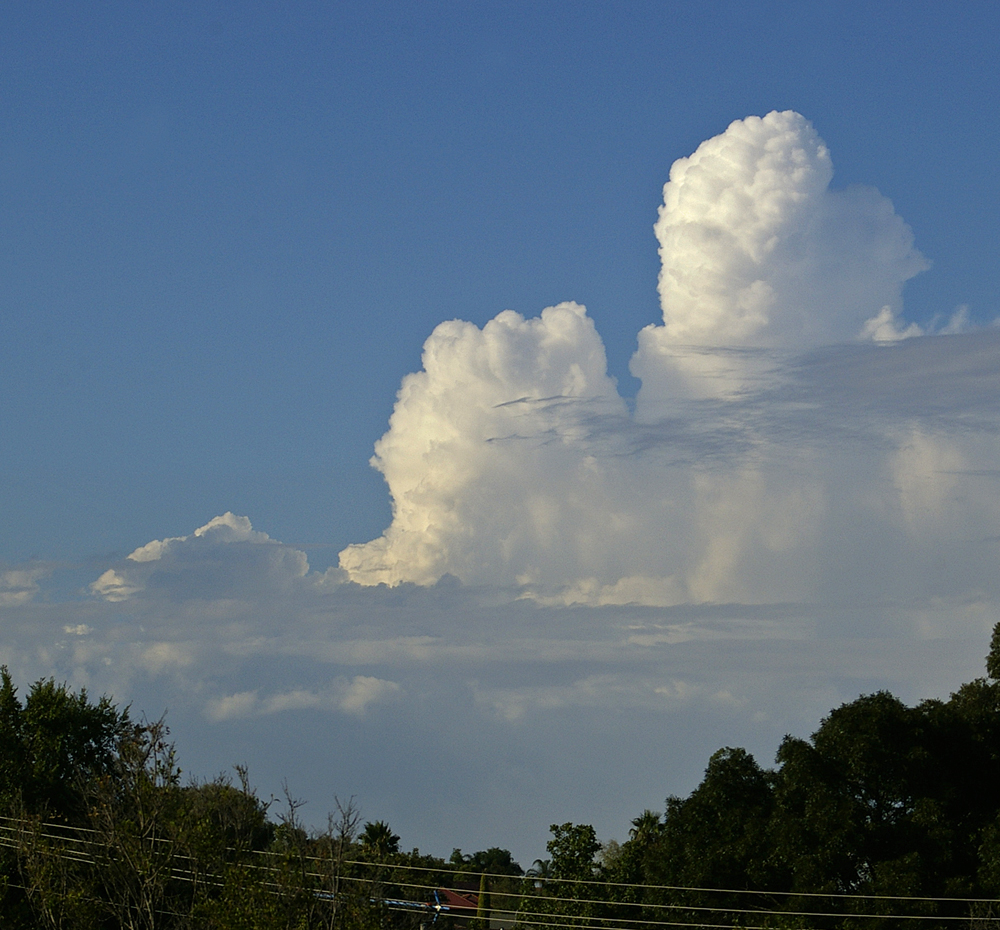
Abbreviations: Cu con (''cumulus congestus'') or Tcu (''towering cumulus'')
=Species
=
;
Cumulus congestus
Cumulus congestus clouds, also known as towering cumulus, are a form of cumulus that can be based in the low or middle height ranges. They achieve considerable vertical development in areas of deep, moist convection. They are an intermediate stage ...
(V-59): These large cumulus clouds have flat dark grey bases and very tall tower-like formations with tops mostly in the high level of the troposphere. The
International Civil Aviation Organization
The International Civil Aviation Organization (ICAO, ) is a specialized agency of the United Nations that coordinates the principles and techniques of international air navigation, and fosters the planning and development of international a ...
(ICAO) designates this species as towering cumulus (Tcu).
=Varieties
=
; Opacity-based varieties: None (always opaque).
; Pattern-based variety: None (not generally discerned with highly unstable cumulus congestus).
=Supplementary features
=
; Precipitation-based supplementary features:
:; Virga: Accompanied by precipitation that evaporates before reaching the ground.
:; Praecipitatio: Produces precipitation that reaches the ground.
; Cloud-based supplementary features:
:; Mamma: Downward facing bubble-like protuberances caused by localized downdrafts within the cloud.
:; Arcus (including
roll and
shelf cloud
An arcus cloud is a low, horizontal cloud formation, usually appearing as an accessory cloud to a cumulonimbus. Roll clouds and shelf clouds are the two main types of arcus clouds. They most frequently form along the leading edge or gust fronts ...
s): Low horizontal cloud formation associated with the leading edge of a thunderstorm outflow.
:; Tuba: Column hanging from the cloud base which can develop into a small funnel cloud.
; Accessory clouds:
:; Pannus: Accompanied by a lower layer of fractus species cloud forming in precipitation.
:; Pileus: Small cap-like cloud over parent cumulus cloud.
:; Velum: A thin horizontal sheet that forms around the middle of a cumulus cloud.
; Mother clouds:
:; Cumulus congestus flammagenitus:
:; Other genitus and mutatus types are the same as for small and moderate cumulus.
Multi-level stratiform and moderate vertical cumuliform (low to mid-level cloud base)
Genus nimbostratus: Multi-level

Abbreviation: Ns
(V-60)
Clouds of the genus
nimbostratus tend to bring constant precipitation and low visibility. This cloud type normally forms above
from altostratus cloud but tends to thicken into the lower levels during the occurrence of precipitation. The top of a nimbostratus deck is usually in the middle level of the troposphere.
=Species
=
No differentiated species (always nebulous).
=Varieties
=
No varieties (always opaque and never forms in patterns).
=Supplementary features
=
; Precipitation-based supplementary features:
:;
Virga
In meteorology, a virga, also called a dry storm, is an observable streak or shaft of precipitation falling from a cloud that evaporates or sublimates before reaching the ground. A shaft of precipitation that does not evaporate before rea ...
: Accompanied by precipitation that evaporates before reaching the ground.
:; Praecipitatio: Produces precipitation that reaches the ground.
;
Accessory cloud:
:; Pannus: Nimbostratus with lower layer of fractus species cloud forming in precipitation.
; Genitus mother clouds
:; Nimbostratus cumulogenitus:
:; Nimbostratus cumulonimbogenitus:
; Mutatus mother clouds:
:; Nimbostratus altostratomutatus:
:; Nimbostratus altocumulomutatus:
:; Nimbostratus stratocumulomutatus:
Genus cumulus: Moderate vertical



Abbreviation: Cu
Moderate vertical cumulus is the product of free convective airmass instability. Continued upward growth suggests showers later in the day.
=Species
=
;
Cumulus mediocris (V-61): Moderate vertical clouds with flat medium grey bases and higher tops than cumulus humilis.
=Varieties
=
: Opacity-based varieties: None (always opaque)
; Pattern-based variety:
:; Cumulus mediocris radiatus (V-62)
(V-60); Moderate cumulus clouds arranged in parallel lines that appear to converge at the horizon.
=Supplementary features
=
: Precipitation-based supplementary features:
:; Virga: Accompanied by precipitation that evaporates before reaching the ground.
:; Praecipitatio: Produces precipitation that reaches the ground.
; Cloud-based supplementary feature:
:; Mamma: Downward facing bubble-like protuberances caused by localized downdrafts within the cloud.
;
Accessory clouds:
:; Pileus; Small cap-like cloud over parent cumulus cloud.
:; Velum: A thin horizontal sheet that forms around the middle of a cumulus cloud.
; Mother clouds: Genitus and mutatus types are the same as for cumulus of little vertical extent.
Low-level stratocumuliform, cumuliform, and stratiform
Low cloud forms from near surface to ca. and are generally composed of water droplets.
Genus stratocumulus

Abbreviation: Sc
Clouds of the genus
stratocumulus
A stratocumulus cloud, occasionally called a cumulostratus, belongs to a genus-type of clouds characterized by large dark, rounded masses, usually in groups, lines, or waves, the individual elements being larger than those in altocumulus, and th ...
are lumpy, often forming in slightly unstable air, and they can produce very light rain or drizzle.
=Species
=
; Stratocumulus stratiformis: Always dividable into opacity-based varieties. Sheets or relatively flat patches of stratocumulus
;
Stratocumulus lenticularis (V-63): Lens-shaped low cloud.
;
Stratocumulus volutus (V-64): Elongated, low-level, tube shaped, horizontal stratocumuliform cloud.
;
Stratocumulus floccus (V-65): Scattered or isolated stratocumulus tufts with domed tops and ragged bases.
;
Stratocumulus castellanus
Stratocumulus castellanus or Stratocumulus castellatus is a type of stratocumulus cloud, castellanus is derived from Latin, meaning 'of a castle' This type of cloud appears as cumuliform turrets vertically rising from a common horizontal cloud b ...
(V-66): Layer of turreted stratocumulus cloud with tower-like formations protruding upwards.
=Varieties
=
; Stratocumuliform opacity-based varieties:
:; Stratocumulus stratiformis translucidus (V-67): Thin translucent stratocumulus through which the sun or moon can be seen.
:; Stratocumulus stratiformis perlucidus (V-68): Opaque low clouds with translucent breaks.
:; Stratocumulus stratiformis opacus (V-69): Opaque stratocumulus clouds.
; Pattern-based variety radiatus: Stratocumulus arranged in parallel bands that appear to converge on the horizon; normally associated with stratiformis species.
:; Stratocumulus stratiformis translucidus radiatus (V-70):
:; Stratocumulus stratiformis perlucidus radiatus (V-71):
:; Stratocumulus stratiformis opacus radiatus (V-72):
; Pattern-based variety duplicatus: Closely spaced layers of stratocumulus, one above the other; normally associated with stratiformis and lenticularis species.
:; Stratocumulus stratiformis translucidus duplicatus (V-73):
:; Stratocumulus stratiformis perlucidus duplicatus (V-74):
:; Stratocumulus stratiformis opacus duplicatus (V-75):
:; Stratocumulus lenticularis duplicatus (V-76):
; Pattern-based variety undulatus: Stratocumulus with wavy undulating base; normally associated with stratiformis and lenticularis species.
:; Stratocumulus stratiformis translucidus undulatus (V-77):
:; Stratocumulus stratiformis perlucidus undulatus (V-78):
:; Stratocumulus stratiformis opacus undulatus (V-79):
:; Stratocumulus lenticularis undulatus (V-80):
; Pattern-based variety lacunosus: Sc with circular holes caused by localized downdrafts; normally associated with stratiformis and castellanus species.
:; Stratocumulus stratiformis translucidus lacunosus (V-81):
:; Stratocumulus stratiformis perlucidus lacunosus (V-82):
:; Stratocumulus stratiformis opacus lacunosus (V-83):
:; Stratocumulus castellanus lacunosus
(V-84):
:; Stratocumulus floccus lacunosus (V-85):
=Supplementary features
=
; Precipitation-based supplementary features: Usually associated with species stratiformis and castellanus.
:; Virga: Low cloud producing precipitation that evaporates before reaching the ground.
:; Praecipitatio: Stratocumulus clouds producing precipitation that reaches the ground.
; Cloud-based supplementary feature:
:; Mamma: Stratocumulus with bubble-like protrusions on the underside; usually associated with species castellanus.
; Genitus mother clouds:
:; Stratocumulus cumulogenitus:
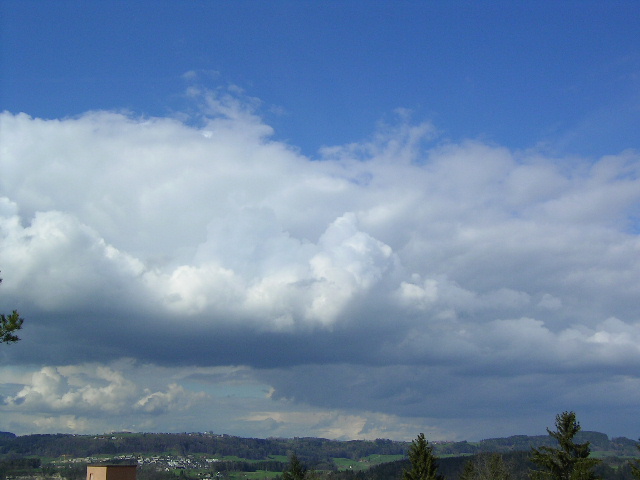
:; Stratocumulus nimbostratogenitus:
:; Stratocumulus cumulonimbogenitus:
:; Stratocumulus altostratogenitus:
; Mutatus mother clouds:
:; Stratocumulus nimbostratomutatus:
:; Stratocumulus altocumulomutatus:
:; Stratocumulus stratomutatus:
Genus cumulus (little vertical extent)
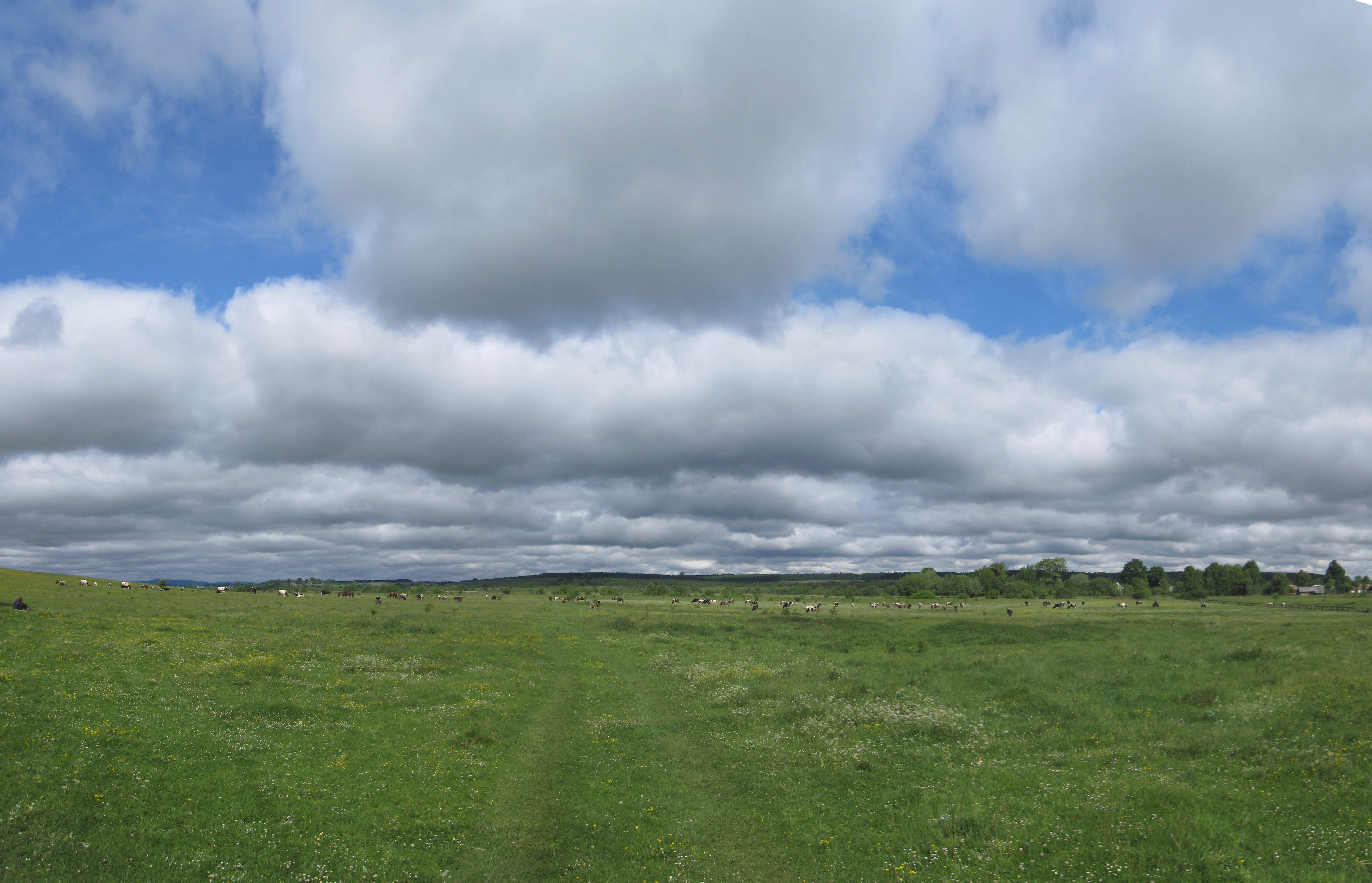
Abbreviation: Cu
These are fair weather cumuliform clouds of limited convection that do not grow vertically. The vertical height from base to top is generally less than the width of the cloud base. They appear similar to stratocumulus but the elements are generally more detached and less wide at the base.
=Species
=
;
Cumulus fractus (V-86): Ragged shreds of cumulus clouds.
;
Cumulus humilis (V-87): "Fair weather clouds" with flat light grey bases and small white domed tops.
=Varieties
=
; Opacity-based varieties: None (always opaque except species fractus which is always translucent).
; Humilis pattern-based variety:
:; Cumulus humilis radiatus (V-88): Small cumulus clouds arranged in parallel lines that appear to converge at the horizon.
= Supplementary features and accessory clouds
=
Not commonly seen with cumulus fractus or humilis.
; Genitus mother clouds
:; Cumulus stratocumulogenitus
:; Cumulus homogenitus: Clouds formed by air-mass convection associated with contained industrial activity.
; Mutatus mother clouds
:; Cumulus stratocumulomutatus
:; Cumulus stratomutatus
;; Cumulus cataractagenitus: Generated by the spray from waterfalls.
Genus stratus

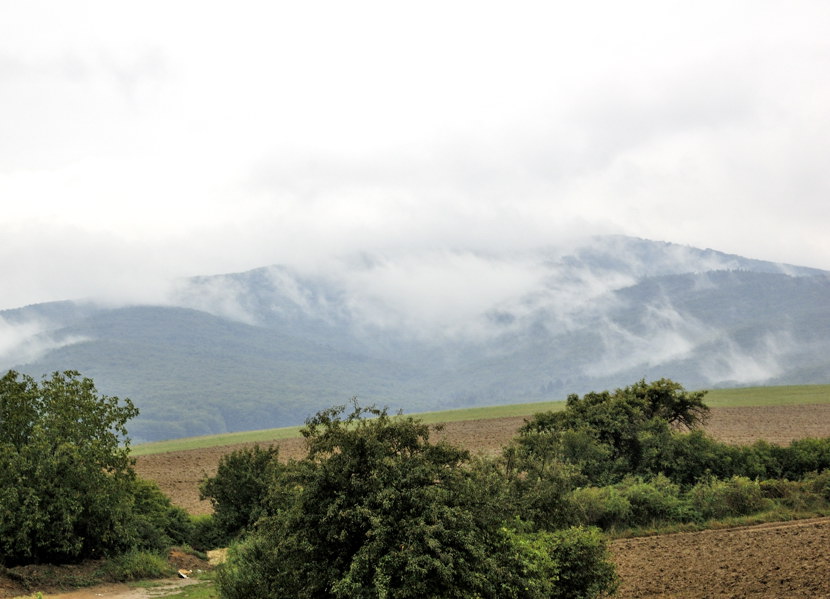
Abbreviation: St
Clouds of the genus
stratus form in low horizontal layers having a ragged or uniform base. Ragged stratus often forms in precipitation while more uniform stratus forms in maritime or other moist stable air mass conditions. The latter often produces drizzle. Stratus that touches the Earth's surface is given the common name,
fog
Fog is a visible aerosol consisting of tiny water droplets or ice crystals suspended in the air at or near the Earth's surface. Reprint from Fog can be considered a type of low-lying cloud usually resembling stratus, and is heavily influ ...
, rather than a Latin name that applies only to clouds that form and remain aloft in the troposphere.
=Species
=
; Stratus nebulosus: Uniform fog-like low cloud.
;
Stratus fractus (V-89): Ragged shreds of stratus clouds usually under base of precipitation clouds.
=Varieties
=
; Nebulosus opacity-based varieties:
:; Stratus nebulosus translucidus (V-90): Thin translucent stratus.
:; Stratus nebulosus opacus (V-91): Opaque stratus that obscures the sun or moon.
; Pattern-based variety undulatus: Wavy undulating base.
:; Stratus nebulosus translucidus undulatus (V-92)
:; Stratus nebulosus opacus undulatus (V-93)
; Varieties are not commonly associated with St species fractus.
=Supplementary features
=
; Precipitation-based supplementary feature:
:; Praecipitatio: Stratus (usually species nebulosus) producing precipitation.
; Accessory clouds: Not usually seen with stratus.
; Genitus mother clouds and other mother sources:
:; Stratus nimbostratogenitus
:; Stratus cumulogenitus
:; Stratus cumulonimbogenitus
:; Stratus cataractagenitus: Generated by the spray from waterfalls.
:; Stratus silvagenitus: A stratus cloud that forms as water vapor is added to the air above a forest.
:; Stratus homogenitus
; Mutatus mother cloud:
:; Stratus stratocumulomutatus
Tropospheric cloud types with Latin etymologies where applicable
''Cloud types are sorted in alphabetical order except where noted''.
WMO genera
;
Altocumulus
Altocumulus (From Latin ''Altus'', "high", ''cumulus'', "heaped") is a middle-altitude cloud genus that belongs mainly to the ''stratocumuliform'' physical category characterized by globular masses or rolls in layers or patches, the individual ele ...
(''altus'' and ''cumulus''): Latin for "high heap": Applied to mid-level stratocumuliform.
;
Altostratus (''altus'' and ''stratus''): "High sheet": Applied to mid-level stratiform.
;
Cirrocumulus (''cirrus'' and ''cumulus''): "Hair-like heap": Applied to high-level stratocumuliform.
;
Cirrostratus
Cirrostratus is a high-level, very thin, generally uniform ''stratiform'' genus-type of cloud. It is made out of ice-crystals, which are pieces of frozen water. It is difficult to detect and it can make halos. These are made when the cloud takes ...
(''cirrus'' and ''stratus''): "Hair-like sheet": Applied to high-level stratiform.
;
Cirrus: "Hair-like": Applied to high-level cirriform.
;
Cumulonimbus
Cumulonimbus (from Latin ''cumulus'', "heaped" and ''nimbus'', "rainstorm") is a dense, towering vertical cloud, typically forming from water vapor condensing in the lower troposphere that builds upward carried by powerful buoyant air currents. ...
(''cumulus'' and ''nimbus''): "Precipitation-bearing heap": Applied to vertical/multi-level cumulonimbiform.
;
Cumulus
Cumulus clouds are clouds which have flat bases and are often described as "puffy", "cotton-like" or "fluffy" in appearance. Their name derives from the Latin ''cumulo-'', meaning ''heap'' or ''pile''. Cumulus clouds are low-level clouds, gener ...
: "Heap": Applied to low-level and vertical/multi-level cumuliform.
;
Nimbostratus (''nimbus'' and ''stratus''): "Precipitation-bearing sheet": Applied to multi-level stratiform with vertical extent that produces precipitation of significant intensity.
;
Stratocumulus
A stratocumulus cloud, occasionally called a cumulostratus, belongs to a genus-type of clouds characterized by large dark, rounded masses, usually in groups, lines, or waves, the individual elements being larger than those in altocumulus, and th ...
(''stratus'' and ''cumulus''): "Sheet-like heap": Applied to low-level stratocumuliform.
;
Stratus: "Sheet": Applied to low-level mostly shallow stratiform.
WMO species
; Castellanus (Cas): Latin for "castle-like": Applies to stratocumuliform (Sc cas, Ac cas, Cc cas) and dense cirriform (Ci cas) with a series of
turret
Turret may refer to:
* Turret (architecture), a small tower that projects above the wall of a building
* Gun turret, a mechanism of a projectile-firing weapon
* Objective turret, an indexable holder of multiple lenses in an optical microscope
* M ...
shapes – indicates air mass instability.
; Congestus (Con): Latin for "congested": Applies to cumuliform (Cu con/Tcu) with great vertical development and heaped into
cauliflower
Cauliflower is one of several vegetables in the species ''Brassica oleracea'' in the genus '' Brassica'', which is in the Brassicaceae (or mustard) family. It is an annual plant that reproduces by seed. Typically, only the head is eaten – t ...
shapes – indicates considerable airmass instability and strong upcurrents.
; Fibratus (Fib): "Fibrous": Cirriform (Ci fib) or high stratiform (Cs fib) in the form of filaments, can be straight or slightly curved; indicates strong, continuous upper winds.
; Floccus (Flo): "Tufted": Applies to stratocumuliform (Sc flo, Ac flo, Cc flo) and high cirriform (Ci flo); indicates some mid or high-level instability.
;
Fractus
Fractus clouds (''scuds'') also known as Fractostratus or Fracto-Cumulus are small, ragged cloud fragments that are usually found under an ambient cloud base. They form or have broken off from a larger cloud, and are generally sheared by strong ...
(Fra): "Broken": Low stratiform (St fra) or cumuliform (Cu fra) with an irregular shredded appearance – forms in precipitation and/or gusty winds.
; Humilis (Hum): "Small": Applies to cumuliform (Cu hum) with little vertical extent; indicates relatively slight airmass instability.
;
Lenticularis (Len): "Lens–like": Stratocumuliform (Sc len, Ac len, Cc len) having a lens-like appearance – formed by standing
wave
In physics, mathematics, and related fields, a wave is a propagating dynamic disturbance (change from equilibrium) of one or more quantities. Waves can be periodic, in which case those quantities oscillate repeatedly about an equilibrium (re ...
s of wind passing over
mountain
A mountain is an elevated portion of the Earth's crust, generally with steep sides that show significant exposed bedrock. Although definitions vary, a mountain may differ from a plateau in having a limited summit area, and is usually higher ...
s or hills.

; Mediocris (Med): "Medium-size": Cumuliform (Cu med) with moderate vertical extent; indicates moderate instability and upcurrents.
; Nebulosus (Neb): "Nebulous": Indistinct low and high stratiform (St neb, Cs neb) without features; indicates light wind if any and stable air mass.
; Spissatus (Spi): "Dense": Thick cirriform (Ci spi) with a grey appearance; indicates some upward movement of air in the upper troposphere.
; Stratiformis (Str): "Sheet-like": Horizontal cloud sheet of flattened stratocumuliform (Sc str, Ac str, Cc str); indicates very slight airmass instability.
; Uncinus (Unc): "Hook-like": Cirriform (Ci unc) with a hook shape at the top; indicates a nearby backside of a weather system.
; Volutus (Vol): "Rolled": Elongated, low or mid-level, tube shaped, stratocumuliform (Sc vol, Ac vol).
The division of genus types into species is as shown in the following table. The genus types (including some cumulus sub-types) are arranged from top to bottom in the left column in approximate descending order of average overall altitude range. The species are sorted from left to right in approximate ascending order of instability or vertical extent of the forms to which each belongs:
# Stratiform species,
# Cirriform species,
# Stratocumuliform species,
# Cumuliform species,
# Cumulonimbiform species.
These ordinal instability numbers appear in each box where a particular genus has a particular species.
WMO varieties
; Opacity-based:
:; Opacus: Latin for "Opaque". A thick sheet of stratiform or stratocumuliform cloud.
:; Perlucidus: "Semi-transparent". Sheet of stratocumuliform cloud with small spaces between elements.
:; Translucidus: "Translucent". Thin translucent patch or sheet of stratiform or stratocumuliform.
; Pattern-based:
:; Duplicatus: Latin for "Double". Closely spaced often partly merged layers of cloud in one of several possible forms.
:; Intortus: "Twisted". Curved and tangled cirriform.
:; Lacunosus: "Full of holes". Thin stratocumuliform cloud distinguished by holes and ragged edges.
:; Radiatus: "Radial". Clouds in one of several possible forms arranged in parallel lines that appear to converge at a central point near the horizon.
:; Undulatus: "Wavy". Stratiform or stratocumuliform cloud displaying an undulating pattern.
:; Vertebratus: "In the form of a back-bone". Cirriform arranged to look like the back-bone of a
vertebrate
Vertebrates () comprise all animal taxa within the subphylum Vertebrata () ( chordates with backbones), including all mammals, birds, reptiles, amphibians, and fish. Vertebrates represent the overwhelming majority of the phylum Chordata, with ...
.
The following table shows the cloud varieties arranged across the top of the chart from left to right in approximate descending order of frequency of appearance. The genus types and some sub-types associated with each variety are sorted in the left column from top to bottom in approximate descending order of average overall altitude range. Where applicable, the genera and varieties are cross-classified to show the species normally associated with each combination of genus and variety. The exceptions comprise the following: Altostratus that have varieties but no species so the applicable boxes are marked without specific species names; cumulus congestus, a species that has its own altitude characteristic but no varieties; cumulonimbus that have species but no varieties, and nimbostratus that has no species or varieties. The boxes for genus and species combinations that have no varieties are left blank.
WMO supplementary features
; Precipitation-based supplementary features:
:; Praecipitatio: Latin for "falling": Cloud whose precipitation reaches the ground.

:;
Virga
In meteorology, a virga, also called a dry storm, is an observable streak or shaft of precipitation falling from a cloud that evaporates or sublimates before reaching the ground. A shaft of precipitation that does not evaporate before rea ...
: "Twig" or "branch": Cloud whose precipitation evaporates before reaching the ground.

; Cloud-based supplementary features:
:;
Arcus: Latin for "arch" or "bow": Feature mostly attached to cumulus, thick with ragged edges.

:; Asperitas: "Roughness": A highly disturbed and chaotic wave feature occasionally seen with a stratocumulus or altocumulus cloud.

:; Cavum: "Hole": Supercooled altocumulus or cirrocumulus distinguished by a hole with ragged edges and virga or wisps of cirrus.
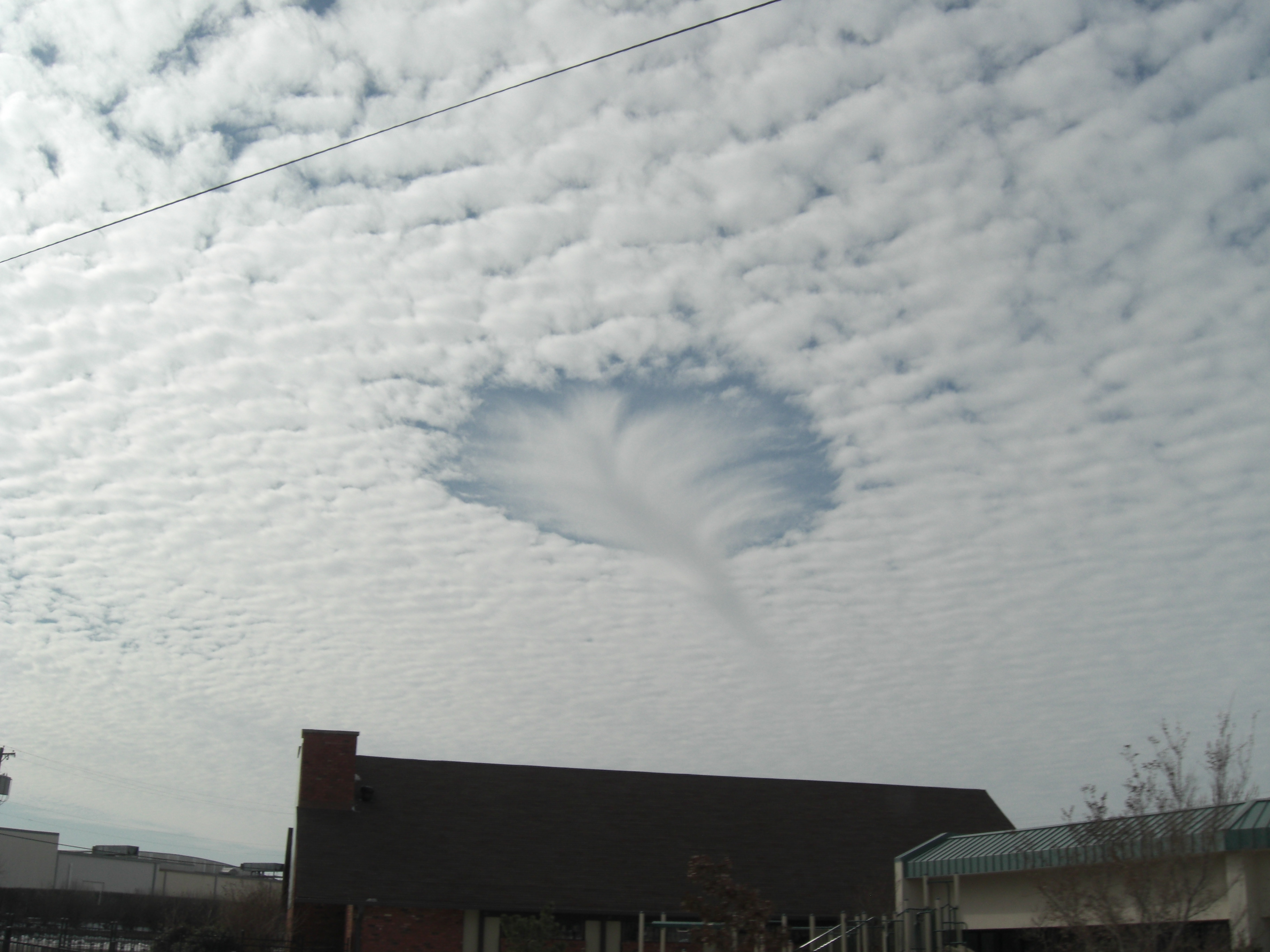
:; Cauda: "Tail": A tail cloud that extends horizontally away from the murus cloud and is the result of air feeding into the storm.

:; Fluctus: Crested wave-like stratocumulus, altocumulus, or cirrus cloud formed by wind-shear.

:; Incus: "Anvil": Top part of a mature cumulonimbus cloud; anvil-shaped feature.

:;
Mammatus
Mammatus (also called mamma or mammatocumulus, meaning "mammary cloud") is a cellular pattern of pouches hanging underneath the base of a cloud, typically a cumulonimbus raincloud, although they may be attached to other classes of parent clou ...
: WMO term ''mamma'': "Breast": A feature in the form of round pouches on under-surface of a cloud.
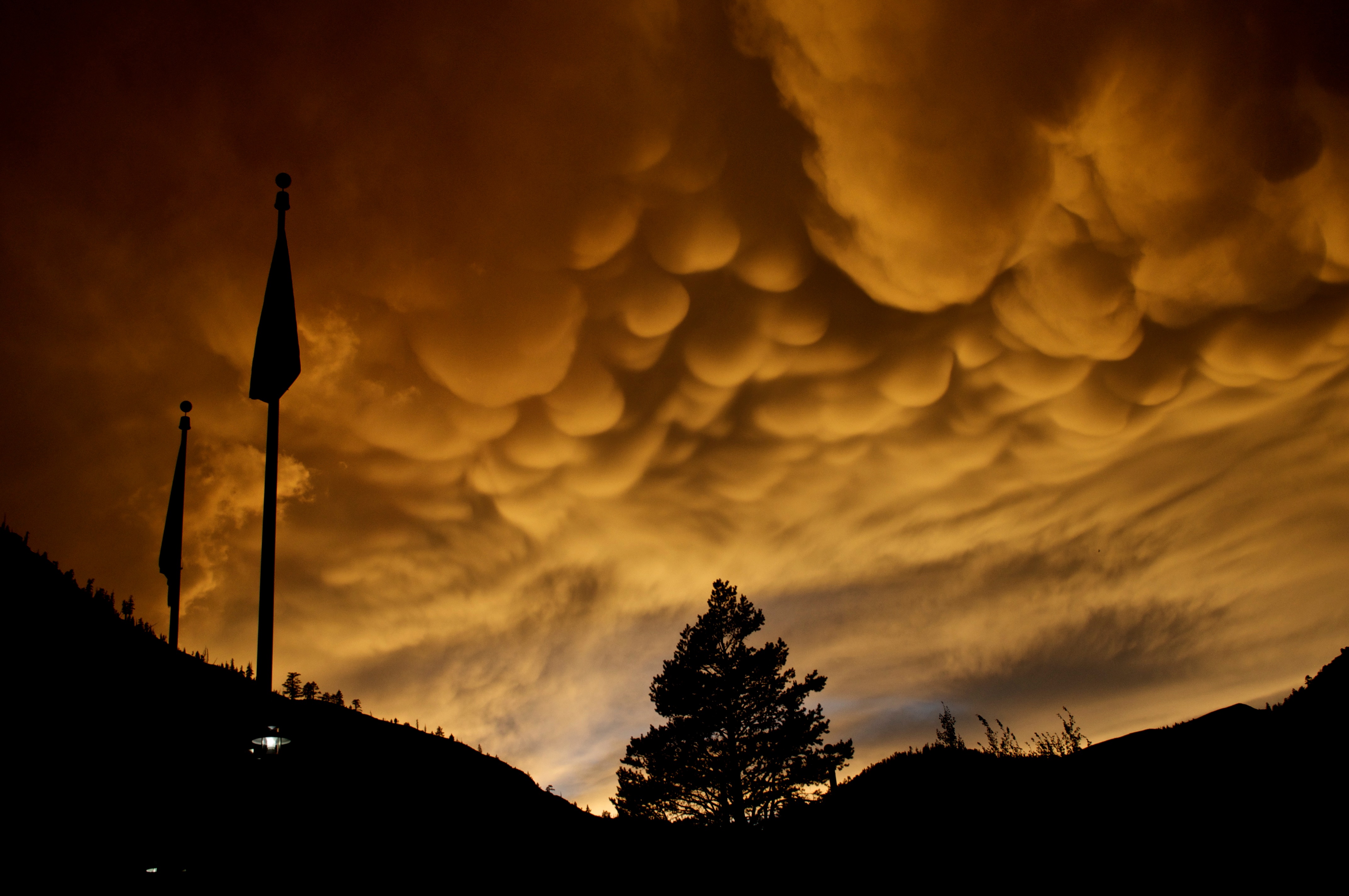
:; Murus: "Wall": Cumulonimbus wall cloud with a lowering rotating base that can portend tornadoes.

:; Tuba: "Funnel" or "tube": Feature in the form of a column hanging from the bottom of cumulus or cumulonimbus.
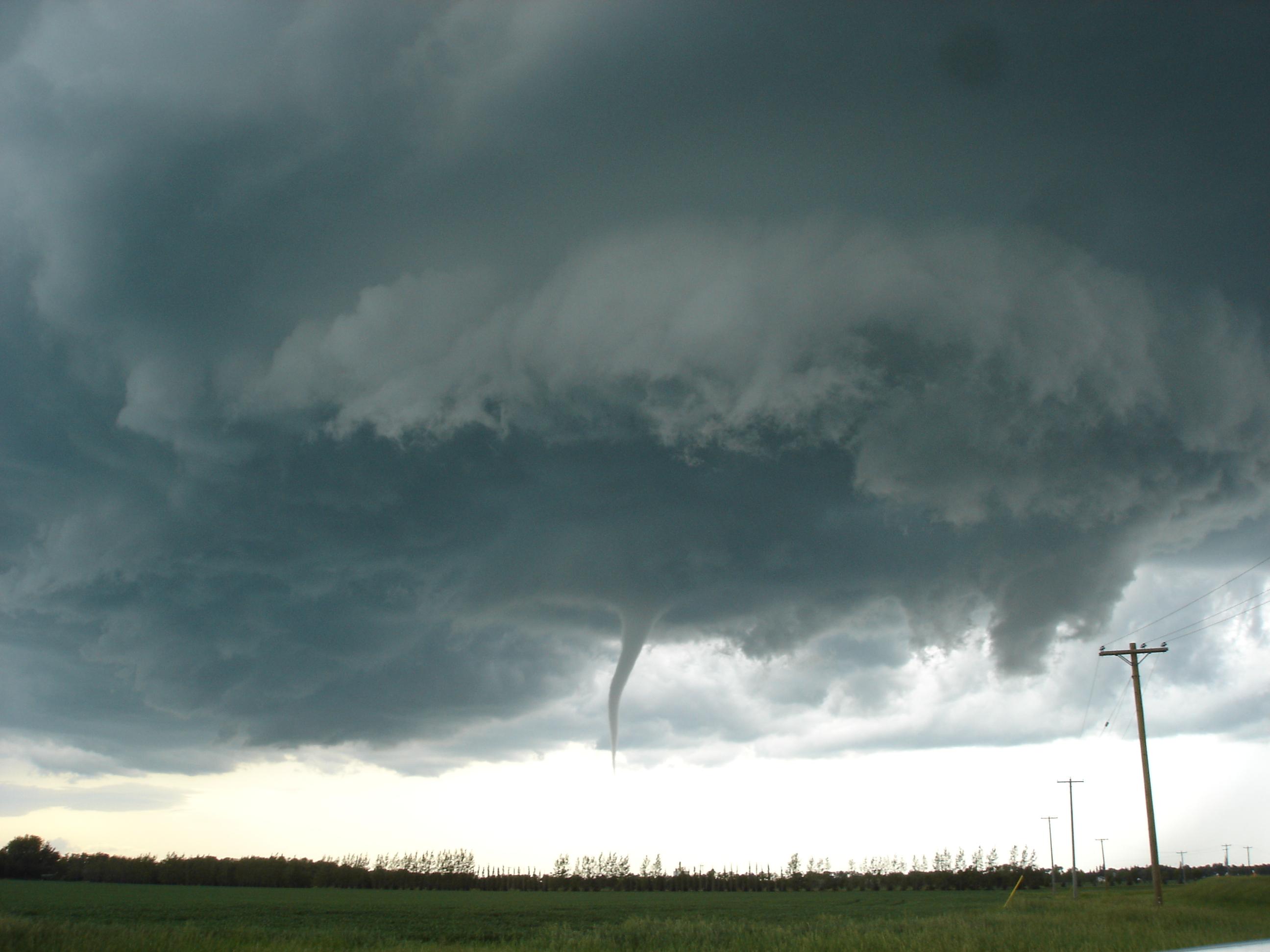
; Accessory clouds:
:; Pannus: Latin for "shredded cloth": A ragged or shredded accessory cloud that forms in precipitation below the main cloud.
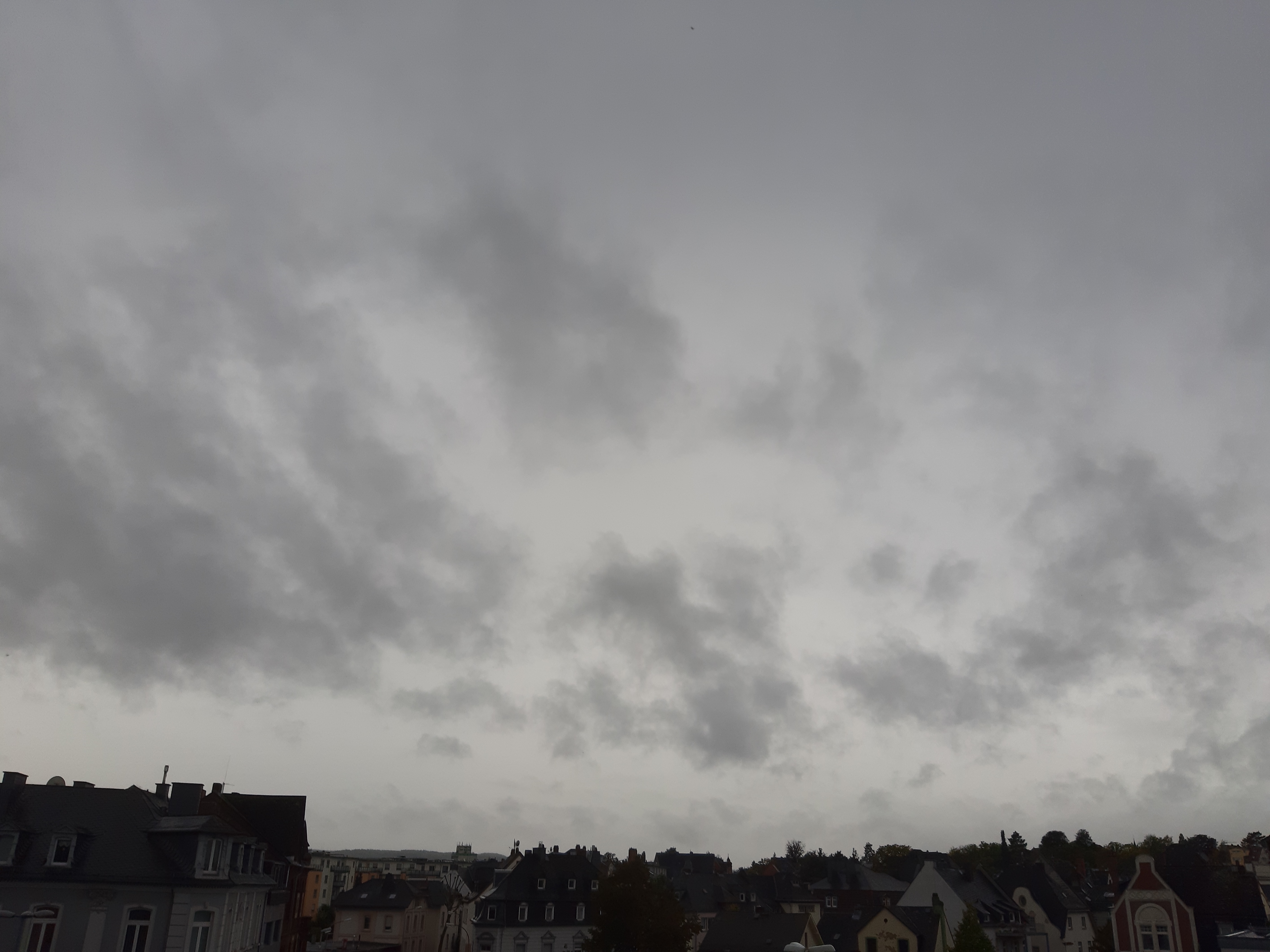
:;
Pileus: "Capped": A hood-shaped accessory cloud.

:; Velum: "A ship's sail": An accessory cloud in the form of a sail.

The supplementary features are associated with particular genera as follows. They are sorted from left to right in approximate decreasing order of frequency of occurrence for each of three categories. The genus types and some sub-types are arranged from top to bottom in approximate descending order of average overall altitude range. Each box is marked where a particular genus or sub-type has a particular supplementary feature.
Genitus mother clouds
; Altocumulogenitus: Formed by the partial transformation of altocumulus mother cloud.
; Altostratogenitus: Formed by the partial transformation of altostratus.
; Cirrogenitus: Partial transformation of cirrus.
; Cirrocumulogenitus: Partial transformation of cirrocumulus.
; Cirrostratogenitus: Partial transformation of cirrostratus.
; Cumulogenitus: Spreading out or partial transformation of cumulus.
; Cumulonimbogenitus: Spreading out or partial transformation of cumulonimbus.
; Nimbostratogenitus: Partial transformation of nimbostratus.
; Stratogenitus: Partial transformation of stratus.
; Stratocumulogenitus: Partial transformation of stratocumulus.
Other genitus clouds
; Cataractagenitus (cataracta-/pertaining to a river cataract): Formed from the mist at a waterfall, the downdraft caused from the cloud is counteracted by the ascending air displacement from the waterfall and may go on to form other types of clouds such as ''cumulus cataractagenitus''.
;
Flammagenitus (flamma-/pertaining to fire): Formed by convection associated with large wildfires.
;
Homogenitus (homo-/pertaining to humans): Formed as a result of human activities, particularly aircraft at high altitudes and heat-generating industrial activities at surface level. If a homogenitus cloud of one genus changes to another genus type, it is then termed a ''homomutatus'' cloud.
;
Silvagenitus (silva-/pertaining to trees or forests): Formed by low-level condensation of water vapor released by vegetation, especially forest canopies.
Mutatus mother clouds
Nomenclature works the same way as for genitus mother clouds except for the ''mutatus'' suffix to indicate the ''complete'' rather than the partial transformation of the original cloud type. e.g. Altocumulomutatus – formed by the complete transformation of altocumulus mother cloud.
The possible combinations of genera and mother clouds can be seen in this table. The genitus and mutatus clouds are each sorted from left to right in alphabetical order. The genus types and some sub-types are arranged from top to bottom in approximate descending order of average overall altitude range. Each box is marked where a particular genus or sub-type has a particular genitus or mutatus mother cloud.
Informal terms recently accepted for WMO classification with Latin nomenclature
;
Aviaticus cloud: Persistent condensation trails (contrails) formed by ice crystals originating from water vapor emitted by aircraft
engine
An engine or motor is a machine designed to convert one or more forms of energy into mechanical energy.
Available energy sources include potential energy (e.g. energy of the Earth's gravitational field as exploited in hydroelectric power ...
s. Usually resembles cirrus; recognized as a WMO genitus cloud cirrus ''homogenitus'' (man-made). Further transformation into cirrus, cirrocumulus, or cirrostratus homomutatus is possible depending on atmospheric stability and wind shear.
;
Fallstreak hole
A fallstreak hole (also known as a cavum, hole punch cloud, punch hole cloud, skypunch, cloud canal or cloud hole) is a large gap, usually circular or elliptical, that can appear in cirrocumulus or altocumulus clouds. The holes are caused by super ...
: Supercooled altocumulus or cirrocumulus distinguished by a hole with ragged edges and virga or wisps of cirrus. Accepted as a WMO supplementary feature to be named ''cavum'' (hole).
;
Kelvin–Helmholtz cloud:
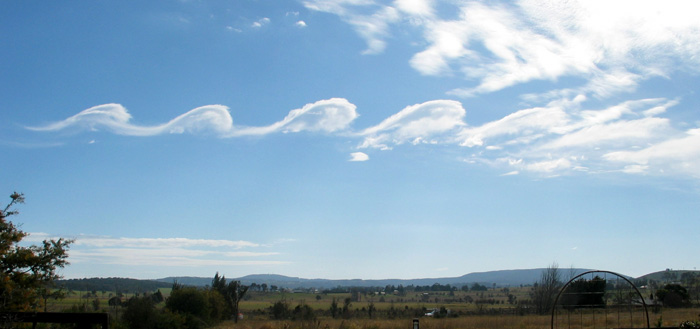
Crested wave-like clouds formed by wind-shear instability that may occur at any altitude in the troposphere. Accepted as a WMO supplementary feature with the Latin name ''fluctus''.
;
Pyrocumulus and
Pyrocumulonimbus: Cumulus and cumulonimbus clouds formed by quickly generated ground heat; including forest fires, volcanic eruptions and low level nuclear detonation. Accepted as a WMO genitus cloud with the Latin name ''flammagenitus'', or ''homogenitus'' in the case of small cumulus formed by contained human activity.
;
Roll cloud:

Elongated, low-level, tube shaped, horizontal formation not associated with a parent cloud. Accepted as a WMO stratocumulus or altocumulus species with the Latin name ''volutus''.
WMO and informal terms related to free-convective cloud types and storms
*
Accessory cloud (WMO supplementary feature) – secondary cloud that is associated with but separate from a main cloud.
*Anvil (WMO supplementary feature incus) – the anvil top of a cumulonimbus cloud.
*Anvil dome (WMO supplementary feature incus) – the
overshooting top
An overshooting top (or penetrating top) is a dome-like protrusion shooting out of the top of the anvil of a thunderstorm and into the lower stratosphere. When an overshooting top is present for 10 minutes or longer, it is a strong indication that ...
on a Cb that is often present on a
supercell
A supercell is a thunderstorm characterized by the presence of a mesocyclone: a deep, persistently rotating updraft. Due to this, these storms are sometimes referred to as rotating thunderstorms. Of the four classifications of thunderstorms ( ...
.
*Anvil rollover – (slang) circular protrusion attached to underside of anvil.
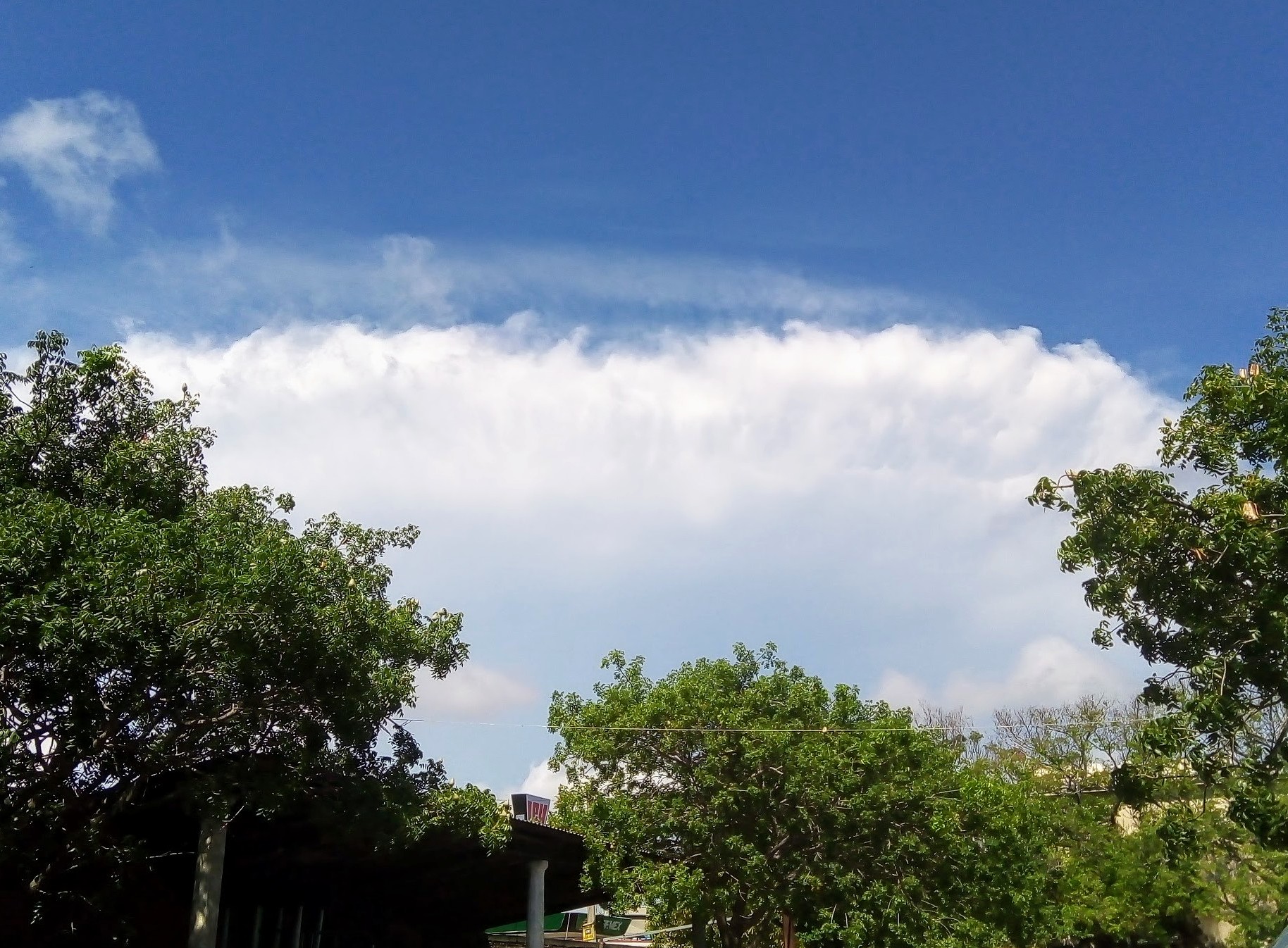
*
Arcus cloud (WMO supplementary feature) – arch or a bow shape, attached to cumulus, thick with ragged edges.
*Backsheared anvil – (slang) anvil that spreads upwind, indicative of extreme weather.
*Clear slot or dry slot (informal term) – an evaporation of clouds as a
rear flank downdraft
The rear flank downdraft (RFD) is a region of dry air wrapping around the back of a mesocyclone in a supercell thunderstorm. These areas of descending air are thought to be essential in the production of many supercellular tornadoes. Large hail ...
descends and dries out cloud and occludes around a
mesocyclone
A mesocyclone is a meso-gamma mesoscale (or storm scale) region of rotation (vortex), typically around in diameter, most often noticed on radar within thunderstorms. In the northern hemisphere it is usually located in the right rear flank (back ...
.
*Cloud tags (WMO species fractus) – ragged detached portions of cloud.
*Collar cloud (WMO velum accessory cloud) – ring shape surrounding upper part of wall cloud.
*Condensation funnel (WMO supplementary feature tuba) – the cloud of a
funnel cloud
A funnel cloud is a funnel-shaped cloud of condensed water droplets, associated with a rotating column of wind and extending from the base of a cloud (usually a cumulonimbus or towering cumulus cloud) but not reaching the ground or a water su ...
aloft or a tornado.
*
Altocumulus castellanus (WMO genus and species) – castle crenellation-shaped altocumulus clouds.
*
Cumulus
Cumulus clouds are clouds which have flat bases and are often described as "puffy", "cotton-like" or "fluffy" in appearance. Their name derives from the Latin ''cumulo-'', meaning ''heap'' or ''pile''. Cumulus clouds are low-level clouds, gener ...
(WMO genus) – heaped clouds.
*
Cumulus castellanus
Cumulus castellanus (from Latin ''castellanus'', castle) is an unofficial name of a species of cumulus cloud that is distinctive because it displays multiple towers arising from its top, indicating significant vertical air movement. It is a misnom ...
– (informal variation of WMO genus and species cumulus congestus) cumulus with tops shaped like castle crenellations.
*
Cumulus congestus
Cumulus congestus clouds, also known as towering cumulus, are a form of cumulus that can be based in the low or middle height ranges. They achieve considerable vertical development in areas of deep, moist convection. They are an intermediate stage ...
(WMO genus and species) – considerable vertical development and heaped into cauliflower shapes.
*
Cumulus fractus (WMO genus and species) – ragged detached portions of cumulus cloud.
*
Cumulus humilis (WMO genus and species) – small, low, flattened cumulus, early development.
*
Cumulus mediocris (WMO genus and species) – medium-sized cumulus with bulges at the top.
*Cumulus pileus (WMO genus and accessory cloud) – capped, hood-shaped cumulus cloud.
*Cumulus praecipitatio (WMO genus and supplementary feature) – cumulus whose precipitation reaches the ground.
*Cumulus radiatus (WMO genus and variety) – cumulus arranged in parallel lines that appear to converge near the horizon.

*Cumulus tuba (WMO genus and supplementary feature) – column hanging from the bottom of cumulus.
*
Cumulonimbus
Cumulonimbus (from Latin ''cumulus'', "heaped" and ''nimbus'', "rainstorm") is a dense, towering vertical cloud, typically forming from water vapor condensing in the lower troposphere that builds upward carried by powerful buoyant air currents. ...
(WMO genus) – heaped towering rain-bearing clouds that stretch to the upper levels of the troposphere.
*
Cumulonimbus calvus (WMO genus and species) – cumulonimbus with round tops like cumulus congestus.
*
Cumulonimbus capillatus (WMO genus and species) – Cb with cirriform top.
*
Cumulonimbus incus
A cumulonimbus incus (Latin ''incus'', " anvil"), also known as an anvil cloud, is a cumulonimbus cloud which has reached the level of stratospheric stability and has formed the characteristic flat, anvil-top shape. It signifies the thunderst ...
(WMO genus and supplementary feature) – Cb capillatus with anvil top.
*Cumulonimbus mamma (WMO genus and supplementary feature) – Cb with pouch-like protrusions that hang from under anvil or cloud base.
*Cumulonimbus pannus (WMO genus and accessory cloud) – shredded sections attached to main Cb cloud.
*Cumulonimbus pileus (WMO genus and accessory cloud) – capped, hood-shaped cloud above a cumulonimbus cloud.
*Cumulonimbus praecipitatio (WMO genus and supplementary feature) – Cb whose precipitation reaches the ground.
*Cumulonimbus tuba (WMO genus and supplementary feature) – column hanging from the bottom of cumulonimbus.
*Debris cloud (informal term) – rotating "cloud" of debris found at base of
tornado
A tornado is a violently rotating column of air that is in contact with both the surface of the Earth and a cumulonimbus cloud or, in rare cases, the base of a cumulus cloud. It is often referred to as a twister, whirlwind or cyclone, alt ...
.
*
Funnel cloud
A funnel cloud is a funnel-shaped cloud of condensed water droplets, associated with a rotating column of wind and extending from the base of a cloud (usually a cumulonimbus or towering cumulus cloud) but not reaching the ground or a water su ...
(WMO supplementary feature tuba) – rotating funnel of cloud hanging from under Cb, not making contact with ground.
*Hail fog (informal term) – a shallow surface layer of
fog
Fog is a visible aerosol consisting of tiny water droplets or ice crystals suspended in the air at or near the Earth's surface. Reprint from Fog can be considered a type of low-lying cloud usually resembling stratus, and is heavily influ ...
that sometimes forms in vicinity of deep
hail
Hail is a form of solid precipitation. It is distinct from ice pellets (American English "sleet"), though the two are often confused. It consists of balls or irregular lumps of ice, each of which is called a hailstone. Ice pellets generally fal ...
accumulation, can be very dense.
*
Hot tower
A hot tower is a tropical cumulonimbus cloud that reaches out of the lowest layer of the atmosphere, the troposphere, and into the stratosphere. These formations are called "hot" because of the large amount of latent heat released as water vapor co ...
(informal term) – a tropical cumulonimbus cloud that penetrates the
tropopause
The tropopause is the atmospheric boundary that demarcates the troposphere from the stratosphere; which are two of the five layers of the atmosphere of Earth. The tropopause is a thermodynamic gradient-stratification layer, that marks the end of ...
.
*Inflow band (informal term) – a laminar band marking inflow to a Cb, can occur at lower or mid levels of the cloud.
*Inverted cumulus (informal variation of WMO supplementary feature mamma) – cumulus which has transferred momentum from an exceptionally intense Cb tower and is convectively growing on the underside of an anvil.
*Knuckles (informal variation of WMO supplementary feature mamma) – lumpy protrusion that hangs from edge or underside of anvil.
*
Pyrocumulus and Pyrocumulonimbus– intense ground-heat cloud proposed for WMO classification (see above).
*Rope – (slang) narrow, sometimes twisted funnel type cloud seen after a tornado dissipates.
*Rope cloud (informal term) – A narrow, long, elongated line of cumulus clouds that sometimes develop at the leading edge of an advancing cold front that is often visible in satellite imagery.
*
Scud cloud (informal term for WMO species fractus) – ragged detached portions of cloud that usually form in precipitation.
*
Shelf cloud
An arcus cloud is a low, horizontal cloud formation, usually appearing as an accessory cloud to a cumulonimbus. Roll clouds and shelf clouds are the two main types of arcus clouds. They most frequently form along the leading edge or gust fronts ...
(informal term for WMO supplementary feature arcus) – wedge-shaped cloud often attached to the underside of Cb.
*Stratus fractus (WMO genus and species) – ragged detached portions of stratus cloud that usually form in precipitation (see also scud cloud).
*Striations (informal term for WMO accessory cloud velum) – a groove or band of clouds encircling an updraft tower, indicative of rotation.
*Tail cloud (informal term) – an area of condensation consisting of laminar band and cloud tags extending from a
wall cloud towards a precipitation core.
*Towering cumulus (TCu) -aviation term for WMO genus and species cumulus congestus, a large cumulus cloud with great vertical development, usually with a cauliflower-like appearance, but lacking the characteristic anvil of a Cb.
*
Wall cloud (informal term) – distinctive fairly large lowering of the rain-free base of a Cb, often rotating.
Other planets
Venus
Thick overcast clouds of
sulfur dioxide
Sulfur dioxide (IUPAC-recommended spelling) or sulphur dioxide (traditional Commonwealth English) is the chemical compound with the formula . It is a toxic gas responsible for the odor of burnt matches. It is released naturally by volcanic a ...
and
carbon dioxide
Carbon dioxide ( chemical formula ) is a chemical compound made up of molecules that each have one carbon atom covalently double bonded to two oxygen atoms. It is found in the gas state at room temperature. In the air, carbon dioxide is t ...
in three main layers at altitudes of 45 to 65 km that obscure the
planet
A planet is a large, rounded astronomical body that is neither a star nor its remnant. The best available theory of planet formation is the nebular hypothesis, which posits that an interstellar cloud collapses out of a nebula to create a you ...
's surface and can produce virga.
; Stratiform: Overcast opaque clouds sheets.
; Stratocumuliform: Wave clouds with clear gaps through which lower stratiform layers may be seen.
; Cumuliform and cumulonimbiform: Embedded convective cells that can produce lightning.
Mars
Clouds resembling several terrestrial types can be seen over Mars and are believed to be composed of
water
Water (chemical formula ) is an inorganic, transparent, tasteless, odorless, and nearly colorless chemical substance, which is the main constituent of Earth's hydrosphere and the fluids of all known living organisms (in which it acts as ...
-
ice.
; Extremely high cirriform: Noctilucent clouds are known to form near the poles at altitudes similar to or higher than the same type of clouds over Earth.
; High cirriform: Thin scattered wispy cloud resembling cirrus through which the planet's surface can be seen.
; High stratocumuliform: Thin scattered wave-cloud resembling cirrocumulus.
; Low stratocumuliform: Wave-cloud resembling stratocumulus, especially as a polar cap cloud over the winter pole which is mostly composed of suspended frozen carbon dioxide.
; Surface-based: Morning fog of water and/or
carbon dioxide
Carbon dioxide ( chemical formula ) is a chemical compound made up of molecules that each have one carbon atom covalently double bonded to two oxygen atoms. It is found in the gas state at room temperature. In the air, carbon dioxide is t ...
commonly forms in low areas of the planet.
Jupiter and Saturn
Cloud decks in parallel latitudinal bands at and below the
tropopause
The tropopause is the atmospheric boundary that demarcates the troposphere from the stratosphere; which are two of the five layers of the atmosphere of Earth. The tropopause is a thermodynamic gradient-stratification layer, that marks the end of ...
alternately composed of
ammonia
Ammonia is an inorganic compound of nitrogen and hydrogen with the formula . A stable binary hydride, and the simplest pnictogen hydride, ammonia is a colourless gas with a distinct pungent smell. Biologically, it is a common nitrogenous ...
crystals and
ammonium
The ammonium cation is a positively-charged polyatomic ion with the chemical formula or . It is formed by the protonation of ammonia (). Ammonium is also a general name for positively charged or protonated substituted amines and quaterna ...
hydrosulfate.
; Cirriform: Bands of cloud resembling cirrus located mainly in the highest of three main layers that cover Jupiter.
; Stratiform and stratocumuliform: Wave and haze clouds that are seen mostly in the middle layer.
; Cumuliform and cumulonimbiform: Convective clouds in the lowest layer that are capable of producing
thunderstorms
A thunderstorm, also known as an electrical storm or a lightning storm, is a storm characterized by the presence of lightning and its acoustic effect on the Earth's atmosphere, known as thunder. Relatively weak thunderstorms are somet ...
and may be composed at least partly of water droplets. an intermediate deck of
ammonium hydrosulfide
Ammonium hydrosulfide is the chemical compound with the formula .
Composition
It is the salt derived from the ammonium cation and the hydrosulfide anion. The salt exists as colourless, water-soluble, micaceous crystals. On Earth the compound ...
, and an inner deck of cumulus water clouds.
Uranus and Neptune
Cloud layers composed mainly of
methane
Methane ( , ) is a chemical compound with the chemical formula (one carbon atom bonded to four hydrogen atoms). It is a group-14 hydride, the simplest alkane, and the main constituent of natural gas. The relative abundance of methane ...
gas.
; Cirriform: High wispy formations resembling cirrus.
; Stratiform: Layers of haze-cloud that lack any distinct features.
; Cumuliform and cumulonimbiform: Lower-based convective clouds that can produce thunderstorms.
See also
*
Cloud species Cloud species are a set of fourteen terms used to describe the shape and structure of clouds. Each one has its name abbreviated to a three letter term.
References
See also
* List of cloud types
The list of cloud types groups all gener ...
Notes and references
External links
Introduction to Clouds (National Weather Service)Ten Basic Cloud Types (National Weather Service)International Cloud Atlas online (Archived)Cloud Appreciation SocietyUK Met Office cloud classification pageCloud Atlas (Atlas Chmur)
(in Polish)
NOAA
{{DEFAULTSORT:List Of Cloud Types
Satellite interpretation
lv:Mākoņu veidu uzskaitījums
pl:Chmura#Klasyfikacja chmur
 Noctilucent clouds are thin clouds that come in a variety of forms based from about and occasionally seen in deep twilight after sunset and before sunrise.
;Type 1 : Veils, very tenuous stratiform; resembles cirrostratus or poorly defined cirrus.
;Type 2 : Long stratocumuliform bands, often in parallel groups or interwoven at small angles. More widely spaced than cirrocumulus bands.
:;2A : Bands with diffuse, blurred edges.
:;2B : Bands with sharply defined edges.
;Type 3: Billows. Clearly spaced, fibrous cirriform, roughly parallel short streaks.
:;3A : Short, straight, narrow streaks.
:;3B : Wave-like structures with undulations.
;Type 4 : Whirls. Partial (or, more rarely, complete) cirriform rings with dark centers.
:;4A : Whirls possessing a small angular radius of curvature, sometimes resembling light ripples on a water surface.
:;4B : Simple curve of medium angular radius with one or more streaks.
:;4C : Whirls with large-scale ring structures.
Noctilucent clouds are thin clouds that come in a variety of forms based from about and occasionally seen in deep twilight after sunset and before sunrise.
;Type 1 : Veils, very tenuous stratiform; resembles cirrostratus or poorly defined cirrus.
;Type 2 : Long stratocumuliform bands, often in parallel groups or interwoven at small angles. More widely spaced than cirrocumulus bands.
:;2A : Bands with diffuse, blurred edges.
:;2B : Bands with sharply defined edges.
;Type 3: Billows. Clearly spaced, fibrous cirriform, roughly parallel short streaks.
:;3A : Short, straight, narrow streaks.
:;3B : Wave-like structures with undulations.
;Type 4 : Whirls. Partial (or, more rarely, complete) cirriform rings with dark centers.
:;4A : Whirls possessing a small angular radius of curvature, sometimes resembling light ripples on a water surface.
:;4B : Simple curve of medium angular radius with one or more streaks.
:;4C : Whirls with large-scale ring structures.
 Polar stratospheric clouds form at very high altitudes in
Polar stratospheric clouds form at very high altitudes in 
 ; Cirrus fibratus (V-1): High clouds having the traditional "mare's tail" appearance. These clouds are long, fibrous, and curved, with no tufts or curls at the ends.
; Cirrus uncinus (V-2): Filaments with up-turned hooks or curls.
; Cirrus spissatus (V-3): Dense and opaque or mostly opaque patches.
;
; Cirrus fibratus (V-1): High clouds having the traditional "mare's tail" appearance. These clouds are long, fibrous, and curved, with no tufts or curls at the ends.
; Cirrus uncinus (V-2): Filaments with up-turned hooks or curls.
; Cirrus spissatus (V-3): Dense and opaque or mostly opaque patches.
;  Abbreviation: Cc.
High-level stratocumuliform clouds of the genus cirrocumulus form when moist air at high tropospheric altitude reaches saturation, creating ice crystals or supercooled water droplets. Limited convective instability at the cloud level gives the cloud a rolled or rippled appearance. Despite the lack of a ''strato-'' prefix, layered cirrocumulus is physically a high stratocumuliform genus.Burroughs, William James; Crowder, Bob (January 2007). ''Weather'', p.216. Fog City Press, San Francisco. .
Abbreviation: Cc.
High-level stratocumuliform clouds of the genus cirrocumulus form when moist air at high tropospheric altitude reaches saturation, creating ice crystals or supercooled water droplets. Limited convective instability at the cloud level gives the cloud a rolled or rippled appearance. Despite the lack of a ''strato-'' prefix, layered cirrocumulus is physically a high stratocumuliform genus.Burroughs, William James; Crowder, Bob (January 2007). ''Weather'', p.216. Fog City Press, San Francisco. .
 Abbreviation: Cs
Abbreviation: Cs
 Clouds of the genus
Clouds of the genus 



 Abbreviation: Ac
Mid-level stratocumuliform clouds of the genus
Abbreviation: Ac
Mid-level stratocumuliform clouds of the genus  Abbreviation: As
Stratiform clouds of the genus altostratus form when a large convectively stable airmass is lifted to condensation in the middle level of the troposphere, usually along a frontal system. Altostratus can bring light rain or snow. If the precipitation becomes continuous, it may thicken into nimbostratus which can bring precipitation of moderate to heavy intensity.
Abbreviation: As
Stratiform clouds of the genus altostratus form when a large convectively stable airmass is lifted to condensation in the middle level of the troposphere, usually along a frontal system. Altostratus can bring light rain or snow. If the precipitation becomes continuous, it may thicken into nimbostratus which can bring precipitation of moderate to heavy intensity.

 Abbreviation: Cb
Clouds of the genus cumulonimbus have very-dark-gray-to-nearly-black flat bases and very high tops that can penetrate the
Abbreviation: Cb
Clouds of the genus cumulonimbus have very-dark-gray-to-nearly-black flat bases and very high tops that can penetrate the  Abbreviations: Cu con (''cumulus congestus'') or Tcu (''towering cumulus'')
Abbreviations: Cu con (''cumulus congestus'') or Tcu (''towering cumulus'')


 Abbreviation: Cu
Moderate vertical cumulus is the product of free convective airmass instability. Continued upward growth suggests showers later in the day.
Abbreviation: Cu
Moderate vertical cumulus is the product of free convective airmass instability. Continued upward growth suggests showers later in the day.
 :; Stratocumulus nimbostratogenitus:
:; Stratocumulus cumulonimbogenitus:
:; Stratocumulus altostratogenitus:
; Mutatus mother clouds:
:; Stratocumulus nimbostratomutatus:
:; Stratocumulus altocumulomutatus:
:; Stratocumulus stratomutatus:
:; Stratocumulus nimbostratogenitus:
:; Stratocumulus cumulonimbogenitus:
:; Stratocumulus altostratogenitus:
; Mutatus mother clouds:
:; Stratocumulus nimbostratomutatus:
:; Stratocumulus altocumulomutatus:
:; Stratocumulus stratomutatus:
 Abbreviation: Cu
These are fair weather cumuliform clouds of limited convection that do not grow vertically. The vertical height from base to top is generally less than the width of the cloud base. They appear similar to stratocumulus but the elements are generally more detached and less wide at the base.
Abbreviation: Cu
These are fair weather cumuliform clouds of limited convection that do not grow vertically. The vertical height from base to top is generally less than the width of the cloud base. They appear similar to stratocumulus but the elements are generally more detached and less wide at the base.

 Abbreviation: St
Clouds of the genus stratus form in low horizontal layers having a ragged or uniform base. Ragged stratus often forms in precipitation while more uniform stratus forms in maritime or other moist stable air mass conditions. The latter often produces drizzle. Stratus that touches the Earth's surface is given the common name,
Abbreviation: St
Clouds of the genus stratus form in low horizontal layers having a ragged or uniform base. Ragged stratus often forms in precipitation while more uniform stratus forms in maritime or other moist stable air mass conditions. The latter often produces drizzle. Stratus that touches the Earth's surface is given the common name,  ; Mediocris (Med): "Medium-size": Cumuliform (Cu med) with moderate vertical extent; indicates moderate instability and upcurrents.
; Nebulosus (Neb): "Nebulous": Indistinct low and high stratiform (St neb, Cs neb) without features; indicates light wind if any and stable air mass.
; Spissatus (Spi): "Dense": Thick cirriform (Ci spi) with a grey appearance; indicates some upward movement of air in the upper troposphere.
; Stratiformis (Str): "Sheet-like": Horizontal cloud sheet of flattened stratocumuliform (Sc str, Ac str, Cc str); indicates very slight airmass instability.
; Uncinus (Unc): "Hook-like": Cirriform (Ci unc) with a hook shape at the top; indicates a nearby backside of a weather system.
; Volutus (Vol): "Rolled": Elongated, low or mid-level, tube shaped, stratocumuliform (Sc vol, Ac vol).
The division of genus types into species is as shown in the following table. The genus types (including some cumulus sub-types) are arranged from top to bottom in the left column in approximate descending order of average overall altitude range. The species are sorted from left to right in approximate ascending order of instability or vertical extent of the forms to which each belongs:
# Stratiform species,
# Cirriform species,
# Stratocumuliform species,
# Cumuliform species,
# Cumulonimbiform species.
These ordinal instability numbers appear in each box where a particular genus has a particular species.
; Mediocris (Med): "Medium-size": Cumuliform (Cu med) with moderate vertical extent; indicates moderate instability and upcurrents.
; Nebulosus (Neb): "Nebulous": Indistinct low and high stratiform (St neb, Cs neb) without features; indicates light wind if any and stable air mass.
; Spissatus (Spi): "Dense": Thick cirriform (Ci spi) with a grey appearance; indicates some upward movement of air in the upper troposphere.
; Stratiformis (Str): "Sheet-like": Horizontal cloud sheet of flattened stratocumuliform (Sc str, Ac str, Cc str); indicates very slight airmass instability.
; Uncinus (Unc): "Hook-like": Cirriform (Ci unc) with a hook shape at the top; indicates a nearby backside of a weather system.
; Volutus (Vol): "Rolled": Elongated, low or mid-level, tube shaped, stratocumuliform (Sc vol, Ac vol).
The division of genus types into species is as shown in the following table. The genus types (including some cumulus sub-types) are arranged from top to bottom in the left column in approximate descending order of average overall altitude range. The species are sorted from left to right in approximate ascending order of instability or vertical extent of the forms to which each belongs:
# Stratiform species,
# Cirriform species,
# Stratocumuliform species,
# Cumuliform species,
# Cumulonimbiform species.
These ordinal instability numbers appear in each box where a particular genus has a particular species.
 :;
:;  ; Cloud-based supplementary features:
:; Arcus: Latin for "arch" or "bow": Feature mostly attached to cumulus, thick with ragged edges.
; Cloud-based supplementary features:
:; Arcus: Latin for "arch" or "bow": Feature mostly attached to cumulus, thick with ragged edges.
 :; Asperitas: "Roughness": A highly disturbed and chaotic wave feature occasionally seen with a stratocumulus or altocumulus cloud.
:; Asperitas: "Roughness": A highly disturbed and chaotic wave feature occasionally seen with a stratocumulus or altocumulus cloud.
 :; Cavum: "Hole": Supercooled altocumulus or cirrocumulus distinguished by a hole with ragged edges and virga or wisps of cirrus.
:; Cavum: "Hole": Supercooled altocumulus or cirrocumulus distinguished by a hole with ragged edges and virga or wisps of cirrus.
 :; Cauda: "Tail": A tail cloud that extends horizontally away from the murus cloud and is the result of air feeding into the storm.
:; Cauda: "Tail": A tail cloud that extends horizontally away from the murus cloud and is the result of air feeding into the storm.
 :; Fluctus: Crested wave-like stratocumulus, altocumulus, or cirrus cloud formed by wind-shear.
:; Fluctus: Crested wave-like stratocumulus, altocumulus, or cirrus cloud formed by wind-shear.
 :; Incus: "Anvil": Top part of a mature cumulonimbus cloud; anvil-shaped feature.
:; Incus: "Anvil": Top part of a mature cumulonimbus cloud; anvil-shaped feature.
 :;
:;  :; Murus: "Wall": Cumulonimbus wall cloud with a lowering rotating base that can portend tornadoes.
:; Murus: "Wall": Cumulonimbus wall cloud with a lowering rotating base that can portend tornadoes.
 :; Tuba: "Funnel" or "tube": Feature in the form of a column hanging from the bottom of cumulus or cumulonimbus.
:; Tuba: "Funnel" or "tube": Feature in the form of a column hanging from the bottom of cumulus or cumulonimbus.
 ; Accessory clouds:
:; Pannus: Latin for "shredded cloth": A ragged or shredded accessory cloud that forms in precipitation below the main cloud.
; Accessory clouds:
:; Pannus: Latin for "shredded cloth": A ragged or shredded accessory cloud that forms in precipitation below the main cloud.
 :; Pileus: "Capped": A hood-shaped accessory cloud.
:; Pileus: "Capped": A hood-shaped accessory cloud.
 :; Velum: "A ship's sail": An accessory cloud in the form of a sail.
:; Velum: "A ship's sail": An accessory cloud in the form of a sail.
 The supplementary features are associated with particular genera as follows. They are sorted from left to right in approximate decreasing order of frequency of occurrence for each of three categories. The genus types and some sub-types are arranged from top to bottom in approximate descending order of average overall altitude range. Each box is marked where a particular genus or sub-type has a particular supplementary feature.
The supplementary features are associated with particular genera as follows. They are sorted from left to right in approximate decreasing order of frequency of occurrence for each of three categories. The genus types and some sub-types are arranged from top to bottom in approximate descending order of average overall altitude range. Each box is marked where a particular genus or sub-type has a particular supplementary feature.
 Crested wave-like clouds formed by wind-shear instability that may occur at any altitude in the troposphere. Accepted as a WMO supplementary feature with the Latin name ''fluctus''.
; Pyrocumulus and Pyrocumulonimbus: Cumulus and cumulonimbus clouds formed by quickly generated ground heat; including forest fires, volcanic eruptions and low level nuclear detonation. Accepted as a WMO genitus cloud with the Latin name ''flammagenitus'', or ''homogenitus'' in the case of small cumulus formed by contained human activity.
; Roll cloud:
Crested wave-like clouds formed by wind-shear instability that may occur at any altitude in the troposphere. Accepted as a WMO supplementary feature with the Latin name ''fluctus''.
; Pyrocumulus and Pyrocumulonimbus: Cumulus and cumulonimbus clouds formed by quickly generated ground heat; including forest fires, volcanic eruptions and low level nuclear detonation. Accepted as a WMO genitus cloud with the Latin name ''flammagenitus'', or ''homogenitus'' in the case of small cumulus formed by contained human activity.
; Roll cloud:  Elongated, low-level, tube shaped, horizontal formation not associated with a parent cloud. Accepted as a WMO stratocumulus or altocumulus species with the Latin name ''volutus''.
Elongated, low-level, tube shaped, horizontal formation not associated with a parent cloud. Accepted as a WMO stratocumulus or altocumulus species with the Latin name ''volutus''.
 * Arcus cloud (WMO supplementary feature) – arch or a bow shape, attached to cumulus, thick with ragged edges.
*Backsheared anvil – (slang) anvil that spreads upwind, indicative of extreme weather.
*Clear slot or dry slot (informal term) – an evaporation of clouds as a
* Arcus cloud (WMO supplementary feature) – arch or a bow shape, attached to cumulus, thick with ragged edges.
*Backsheared anvil – (slang) anvil that spreads upwind, indicative of extreme weather.
*Clear slot or dry slot (informal term) – an evaporation of clouds as a  *Cumulus tuba (WMO genus and supplementary feature) – column hanging from the bottom of cumulus.
*
*Cumulus tuba (WMO genus and supplementary feature) – column hanging from the bottom of cumulus.
*